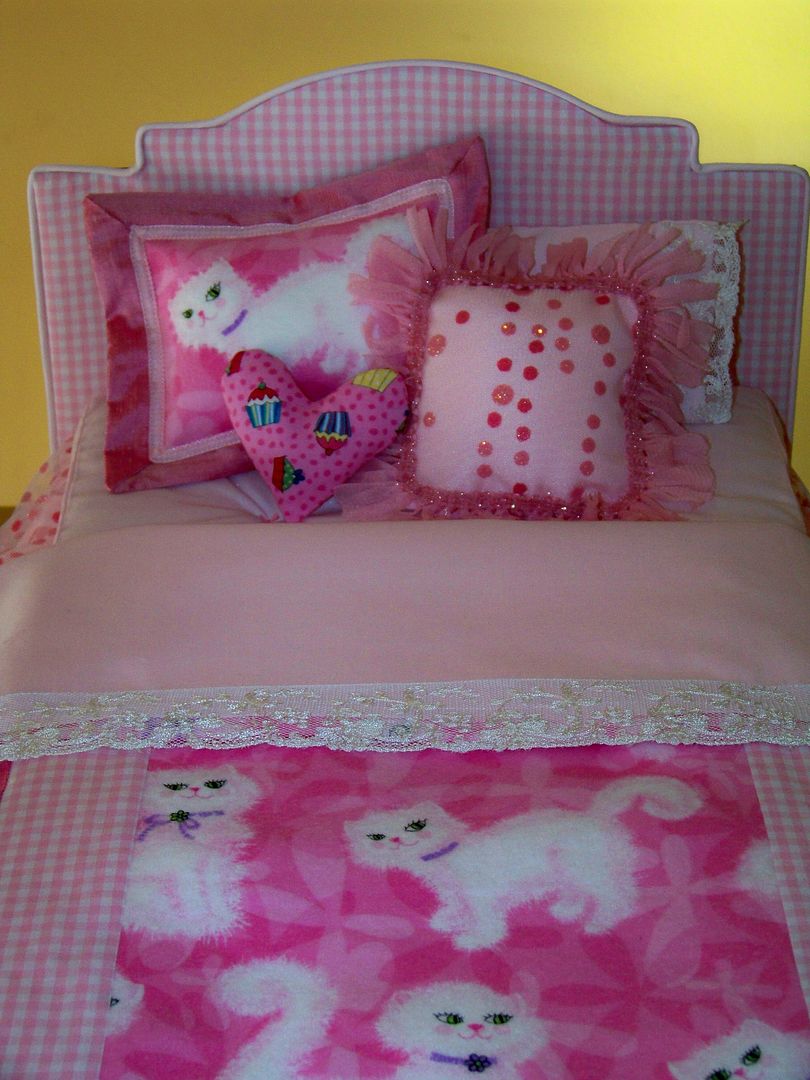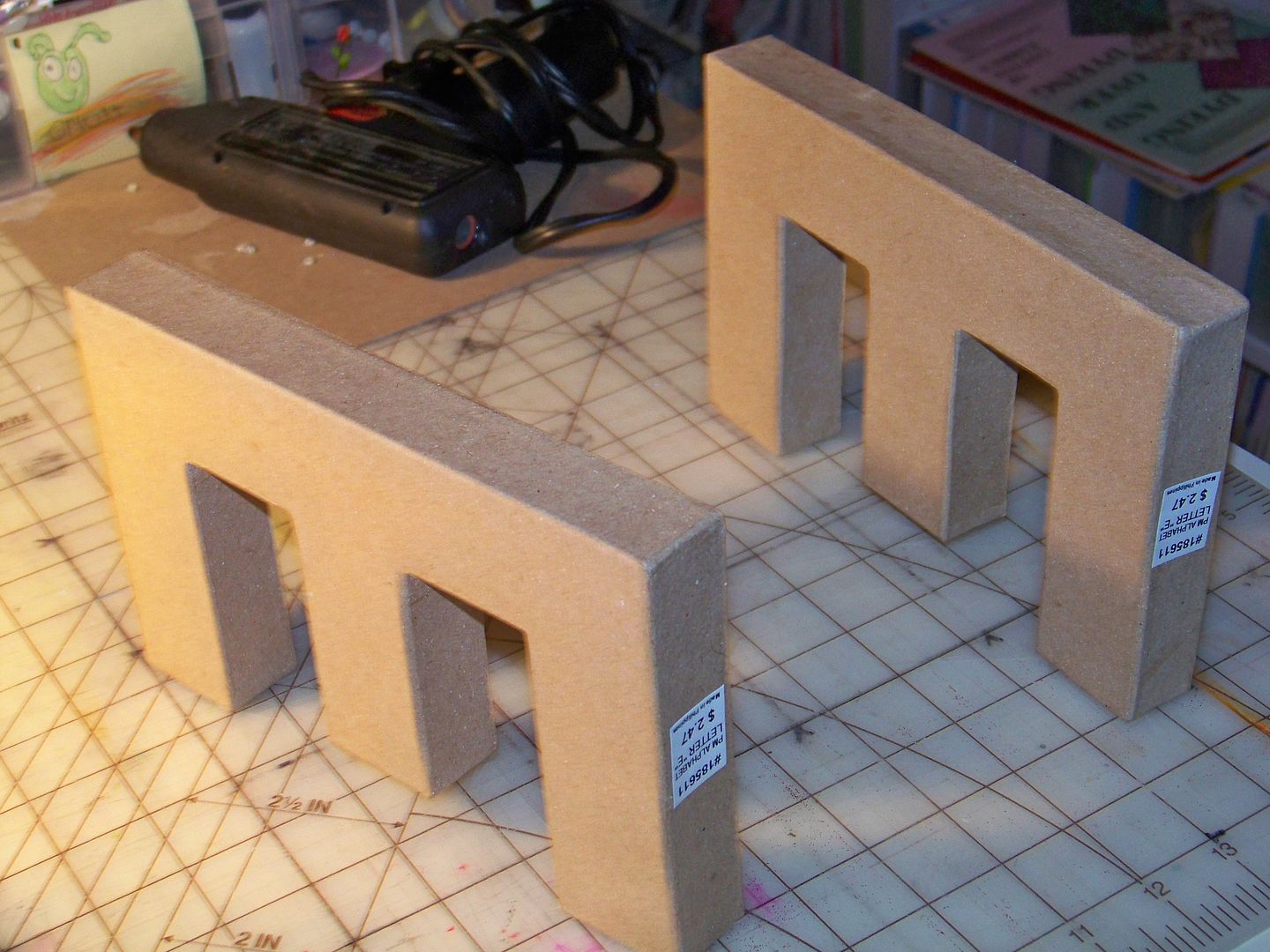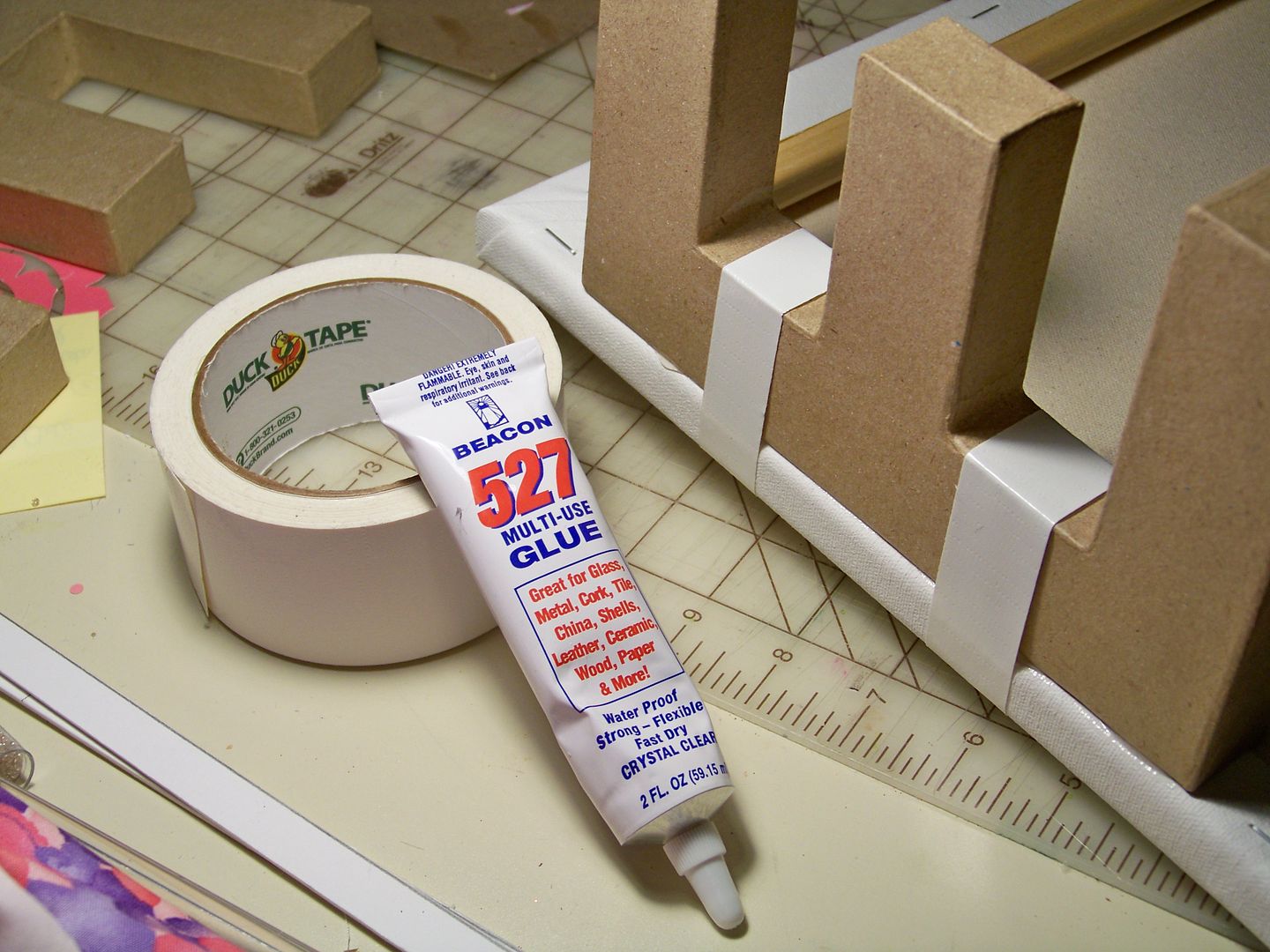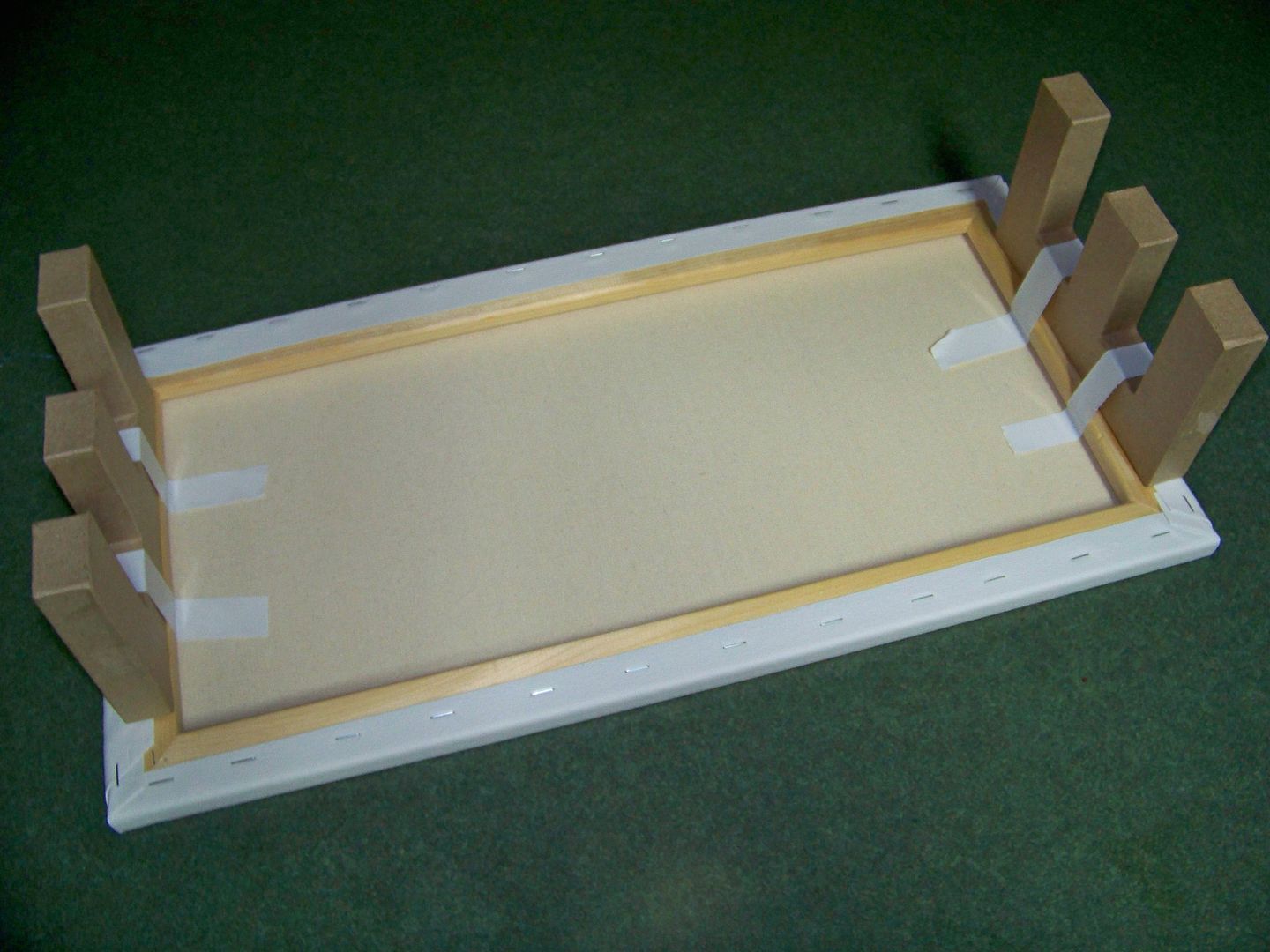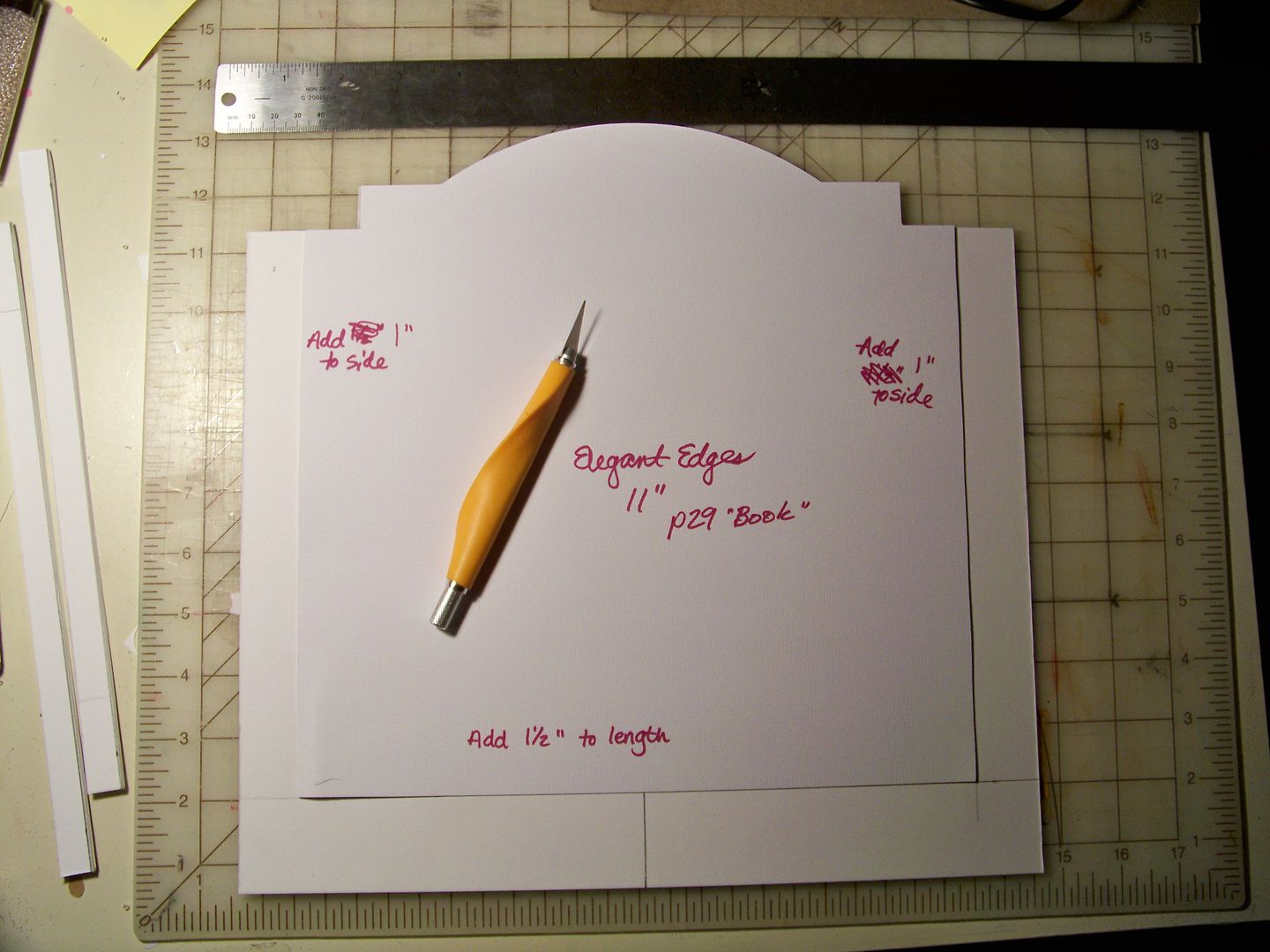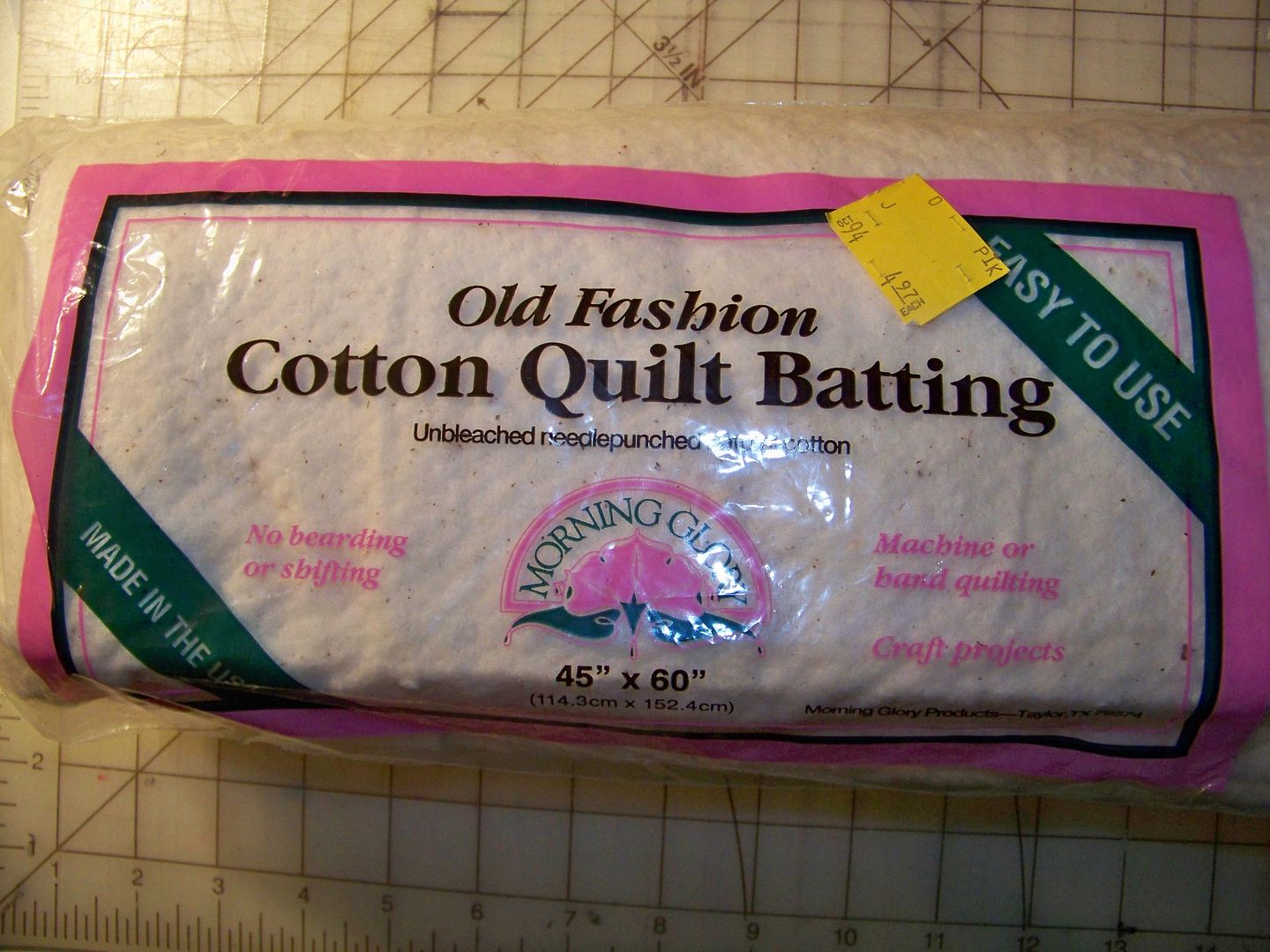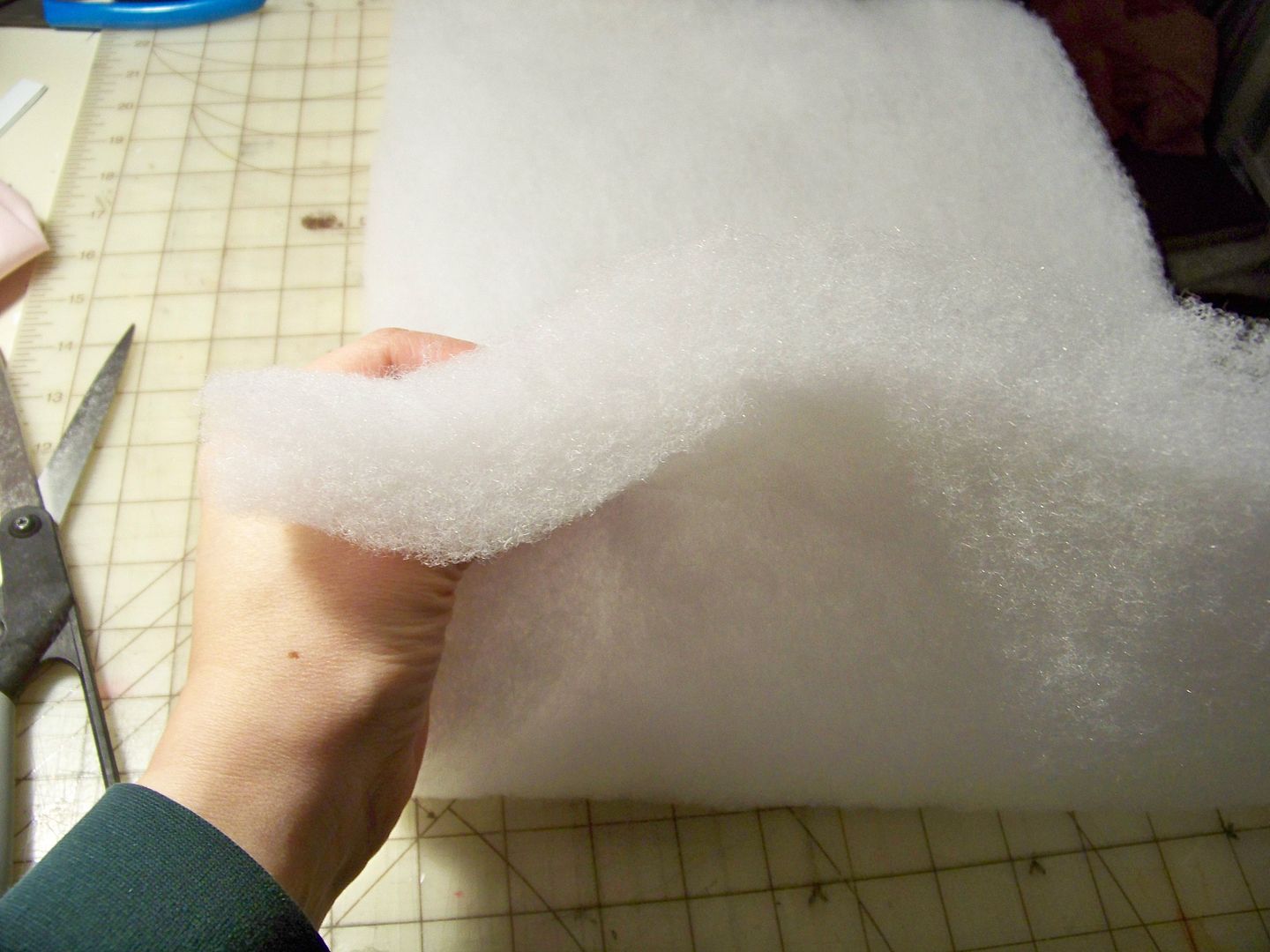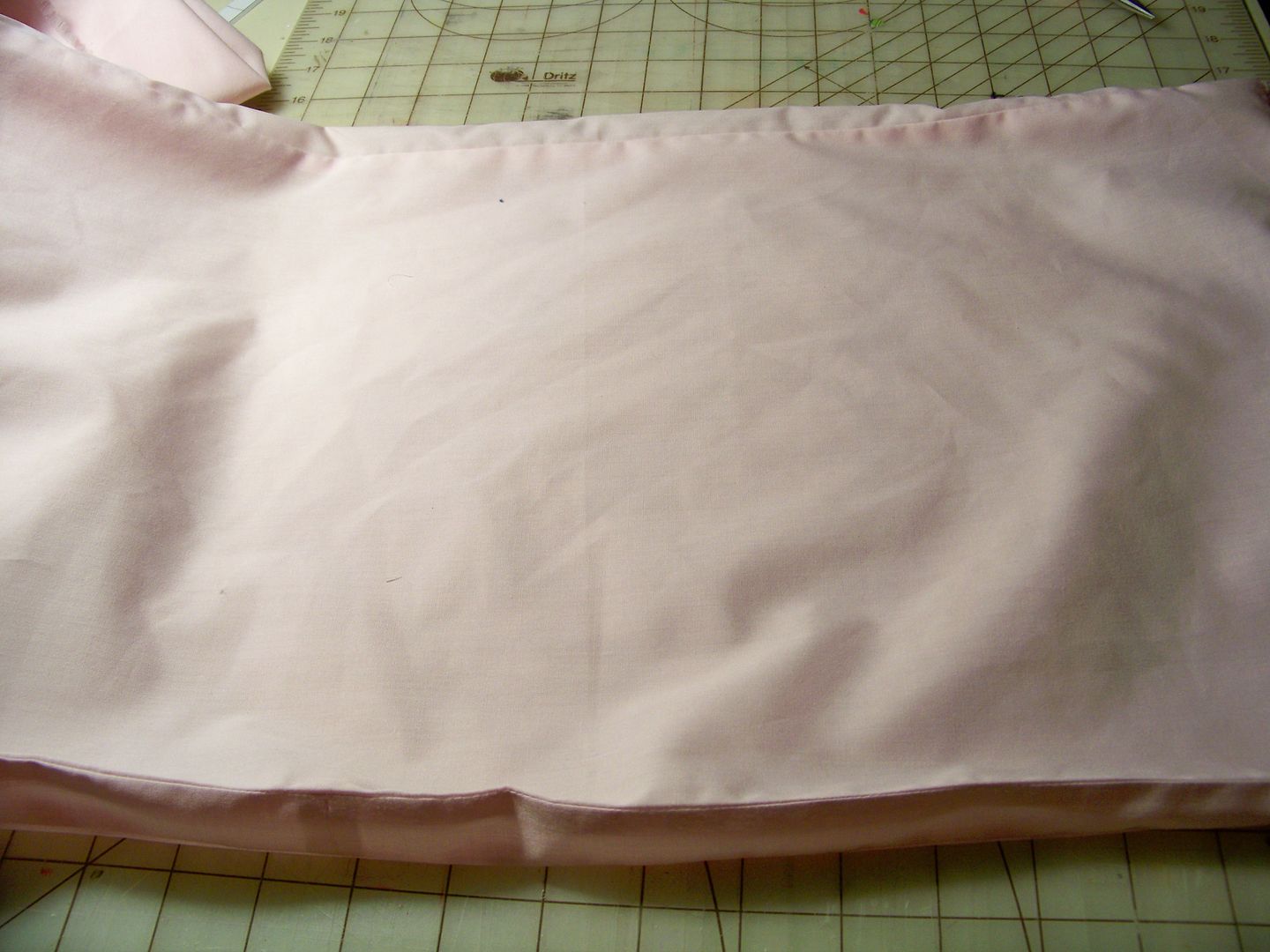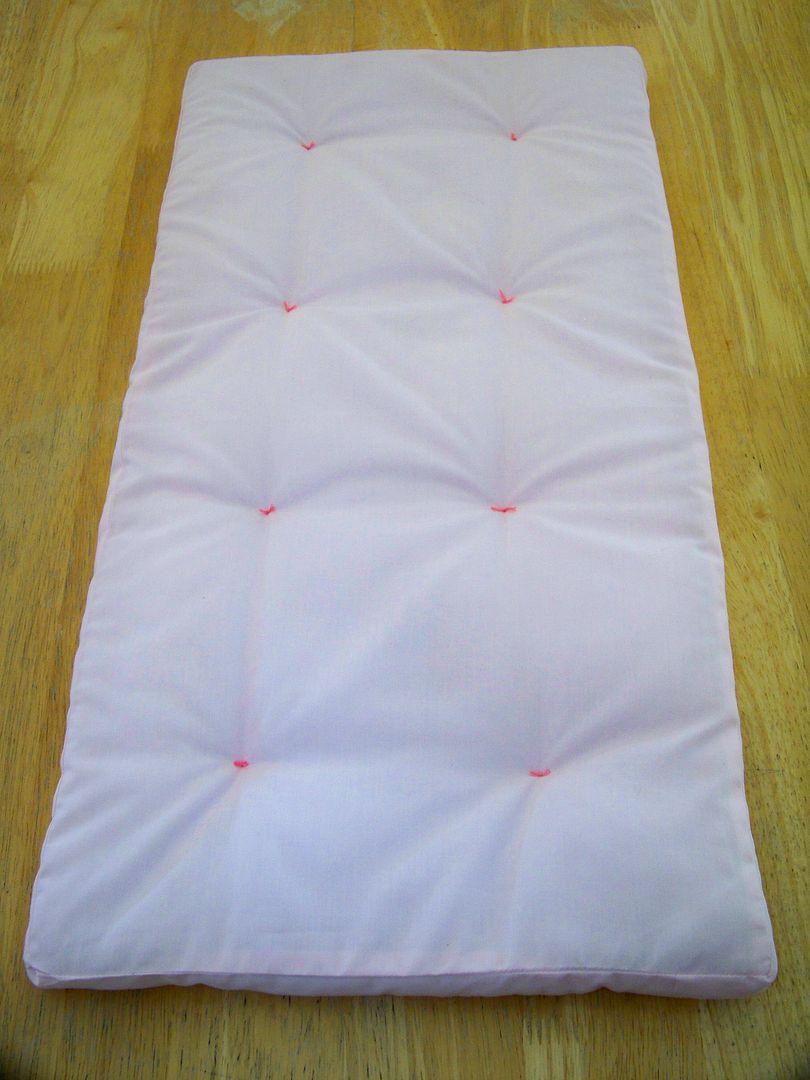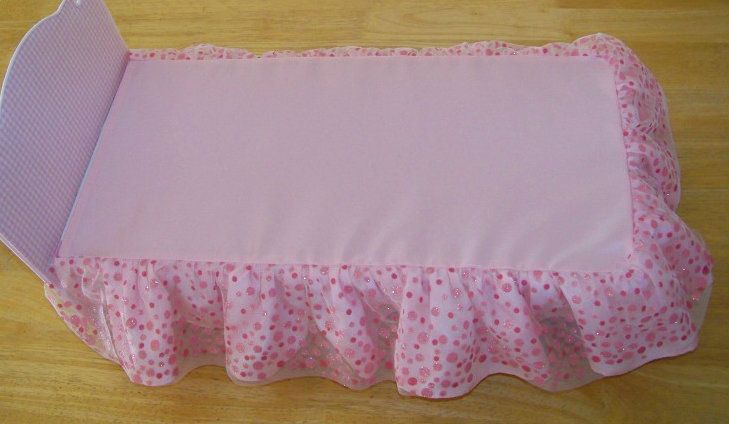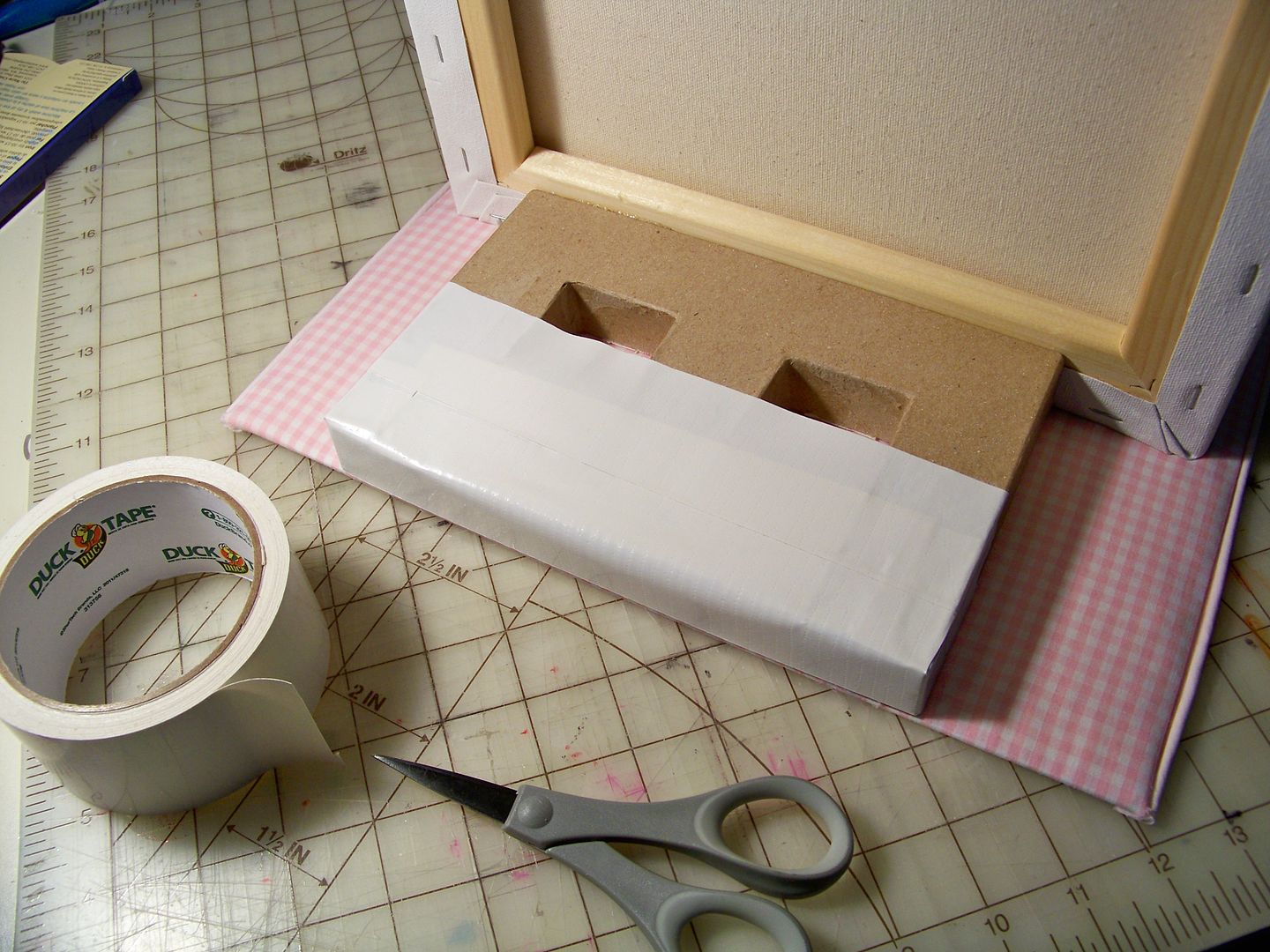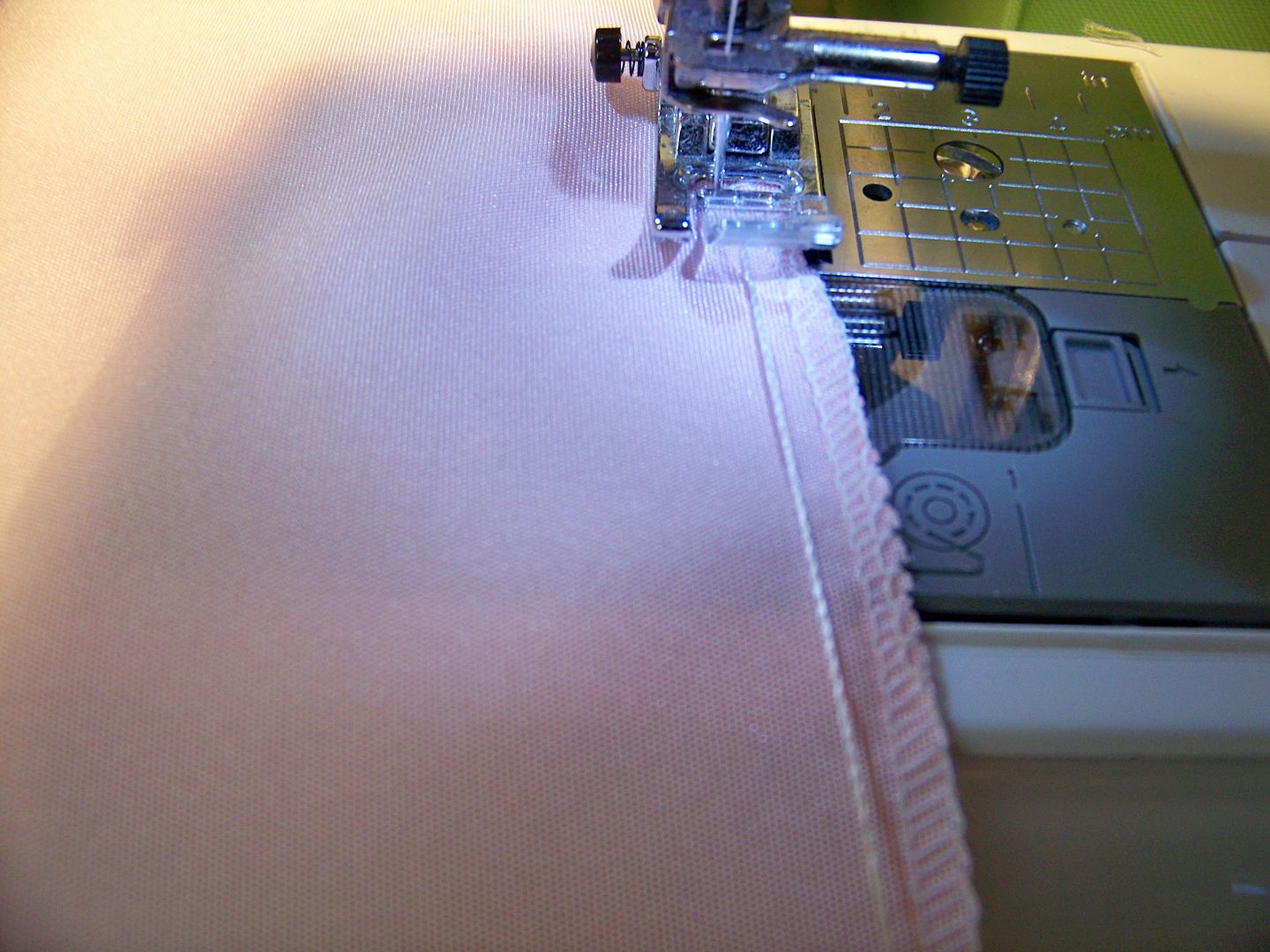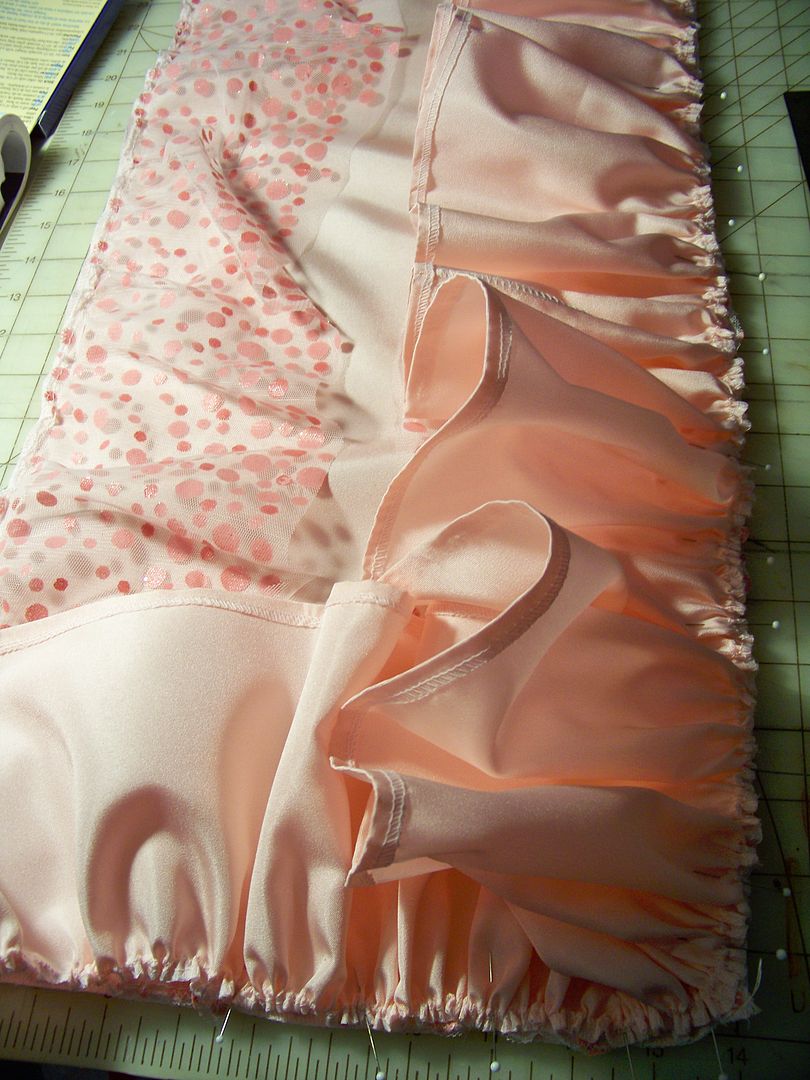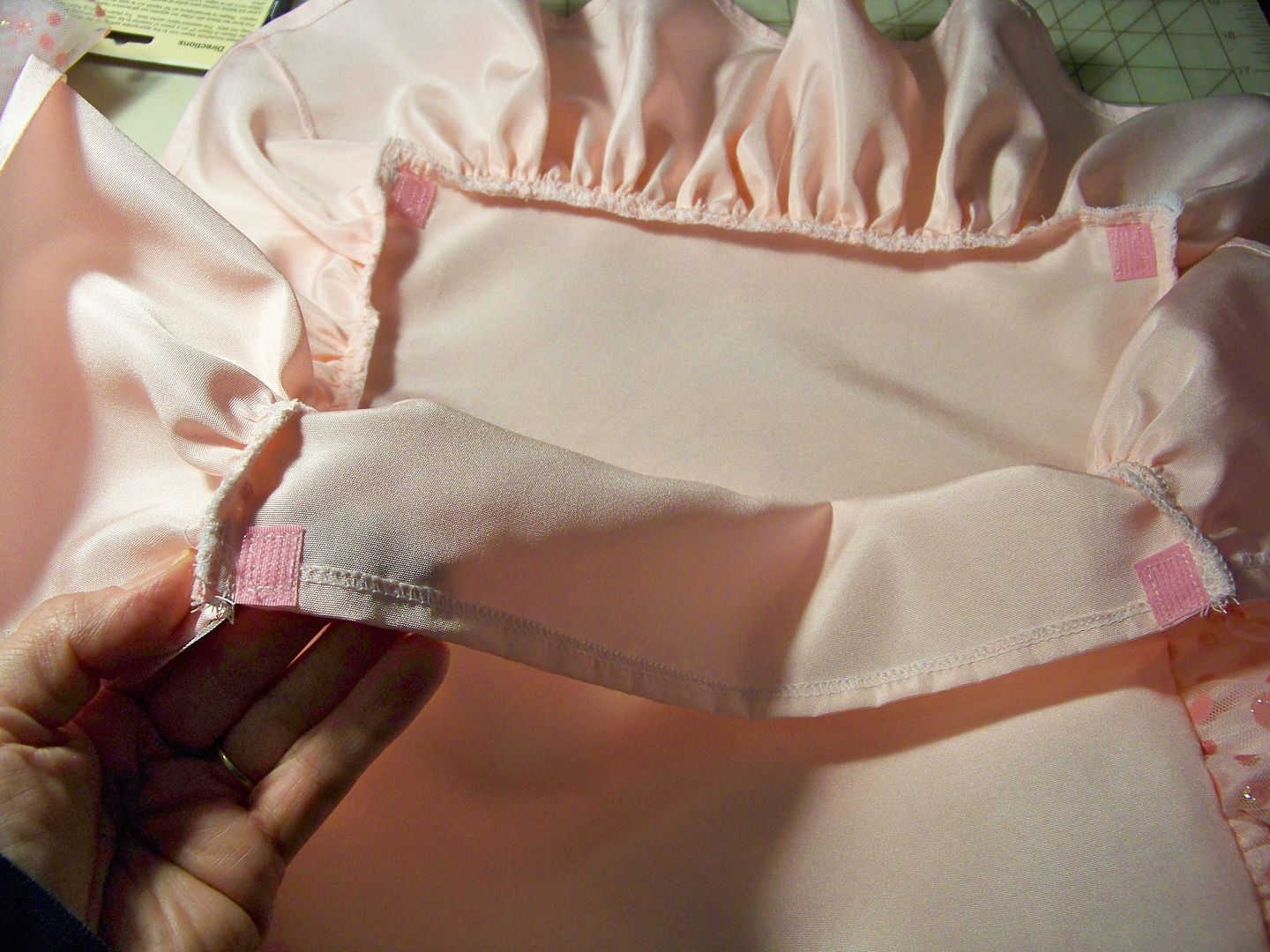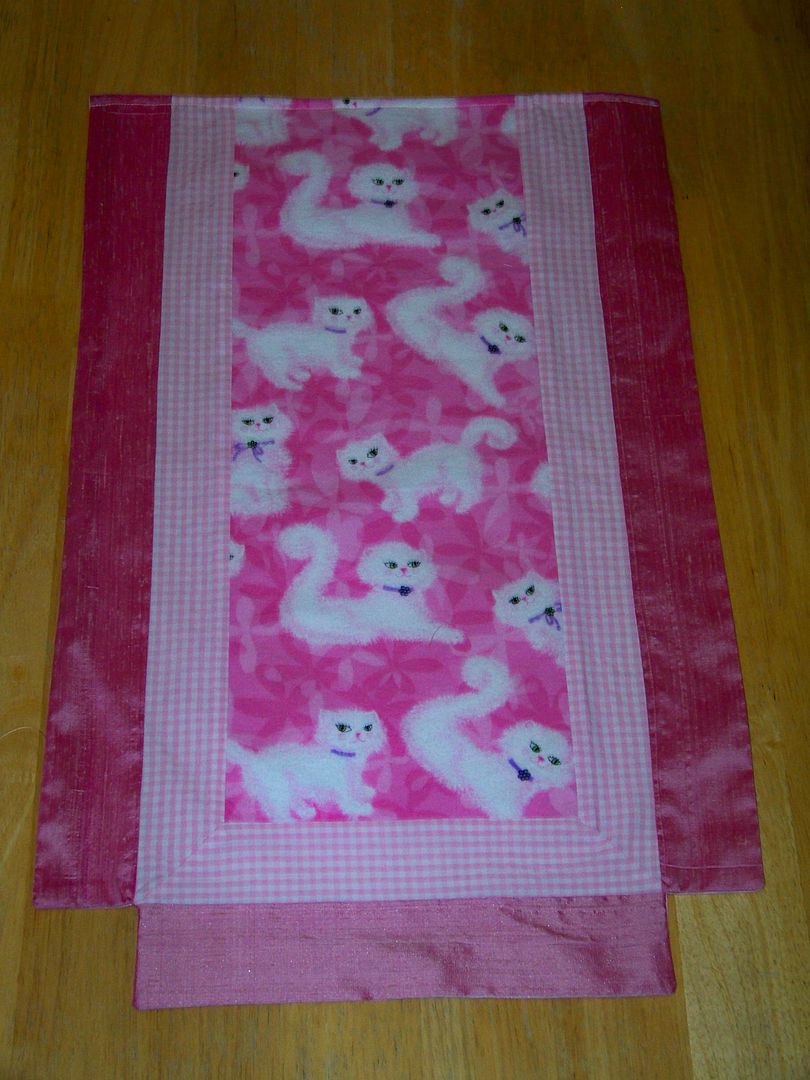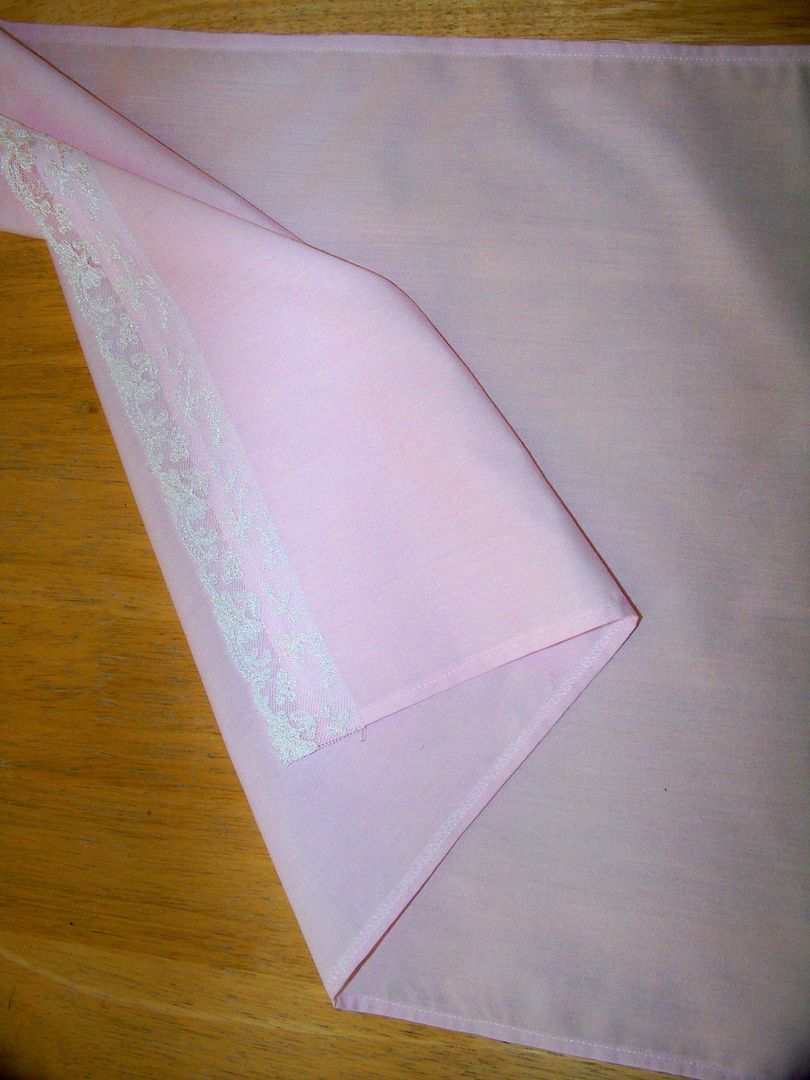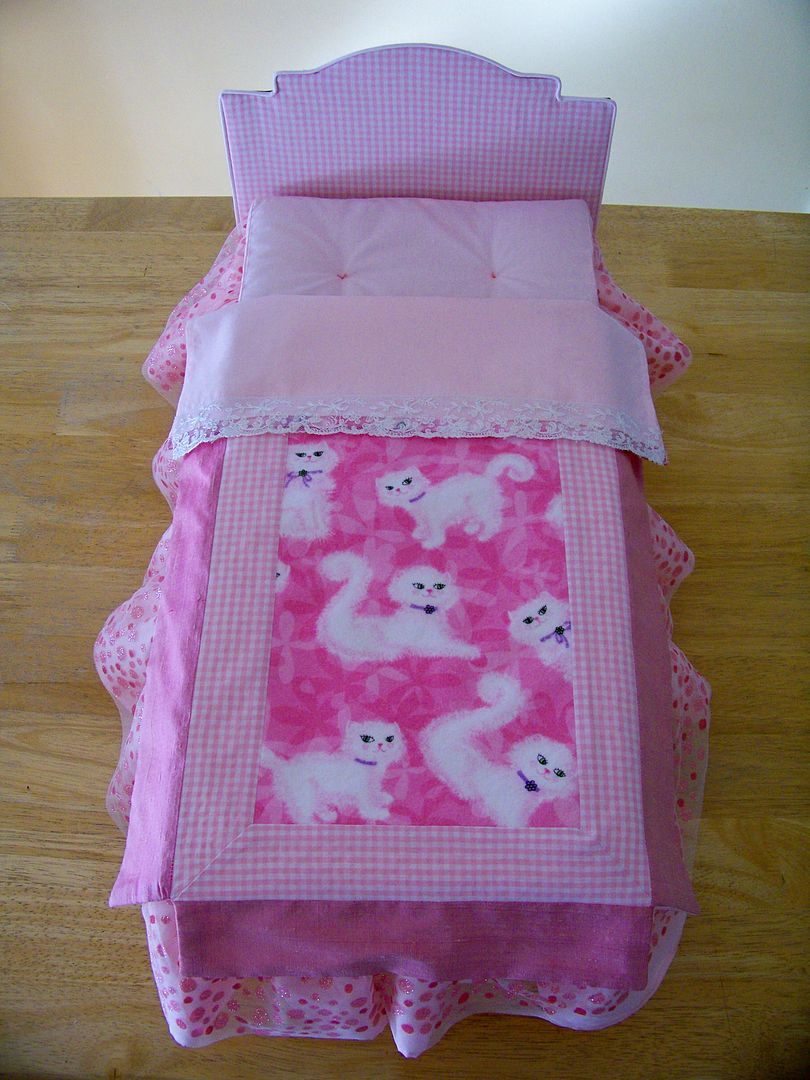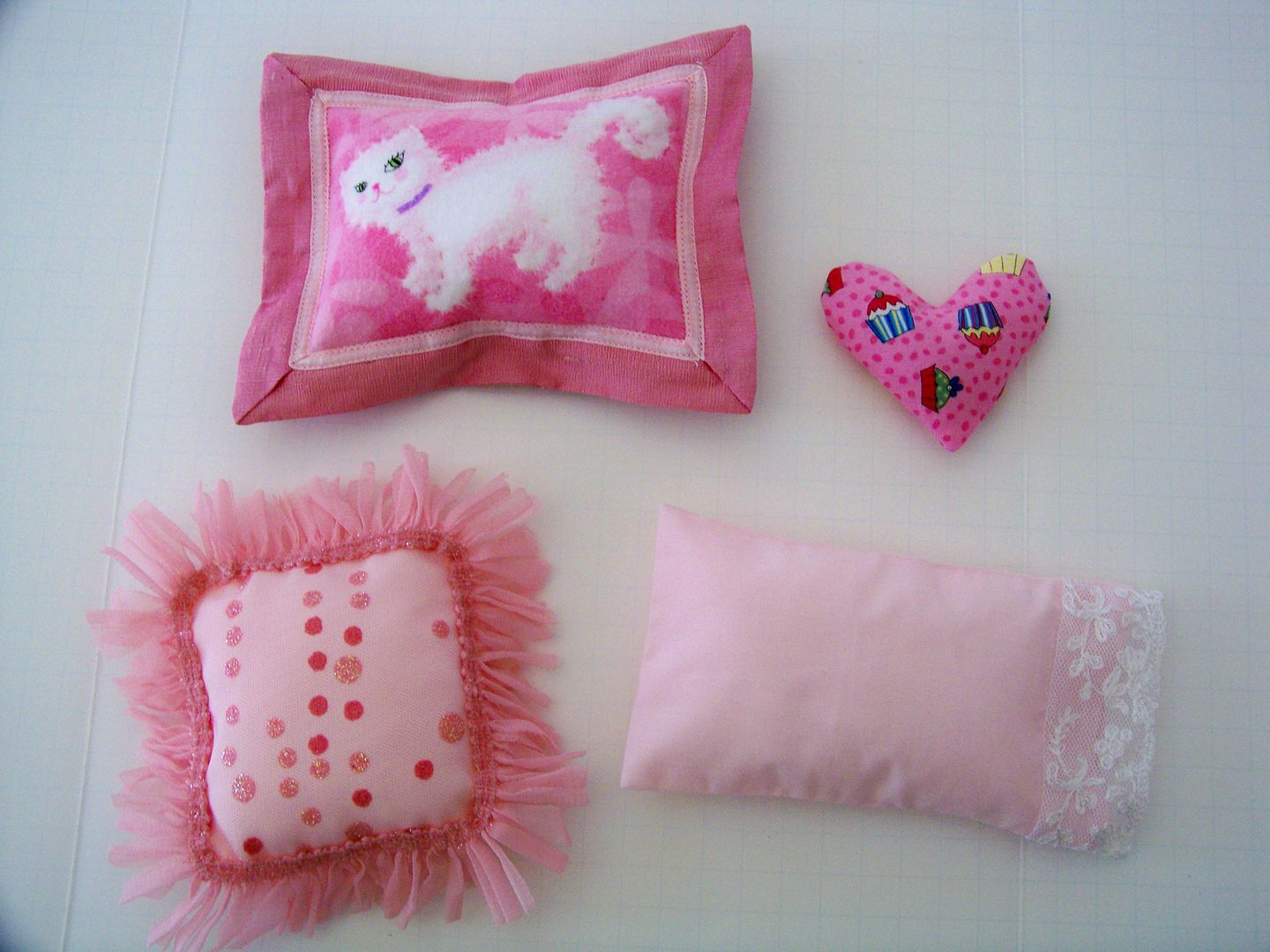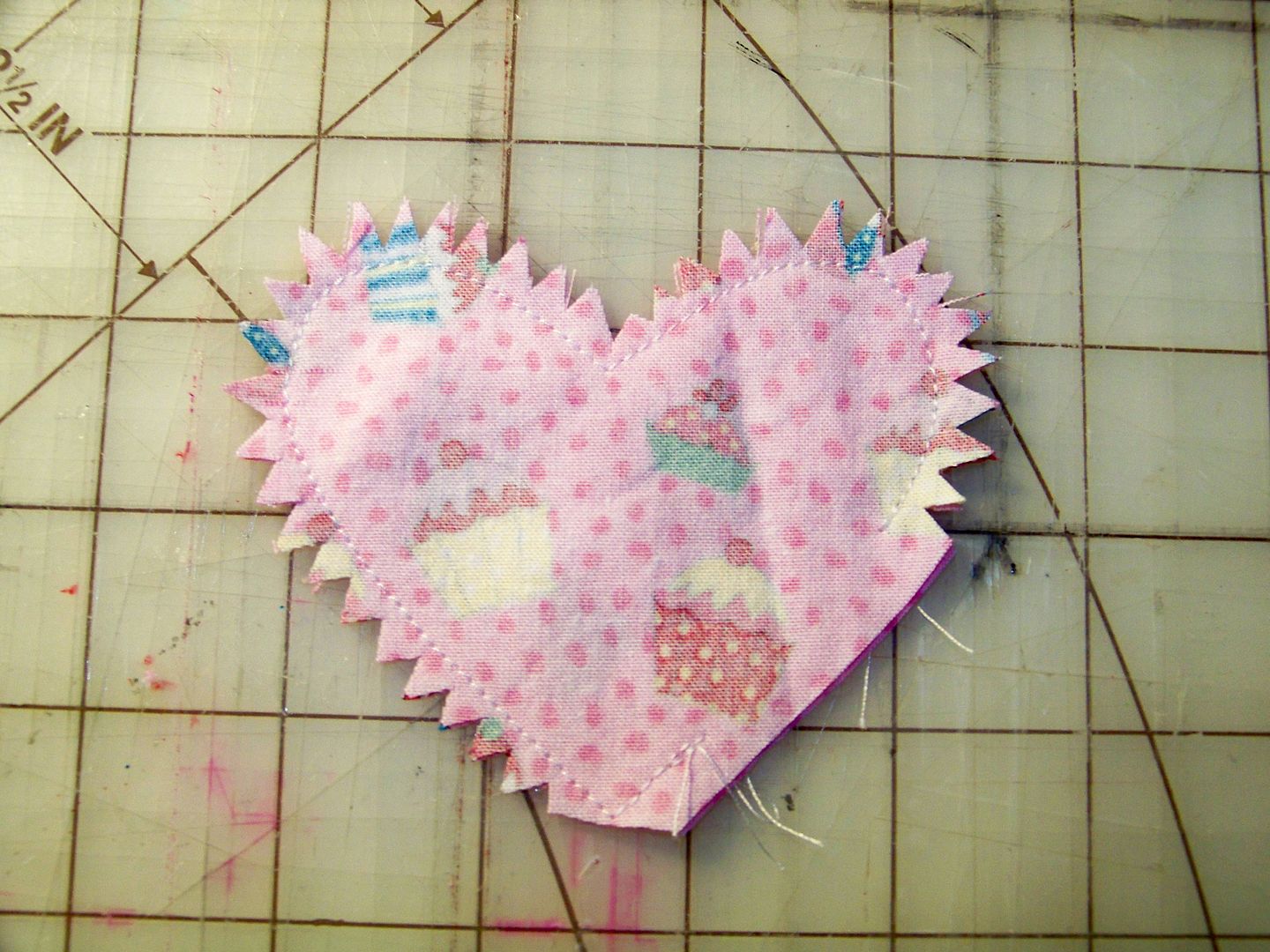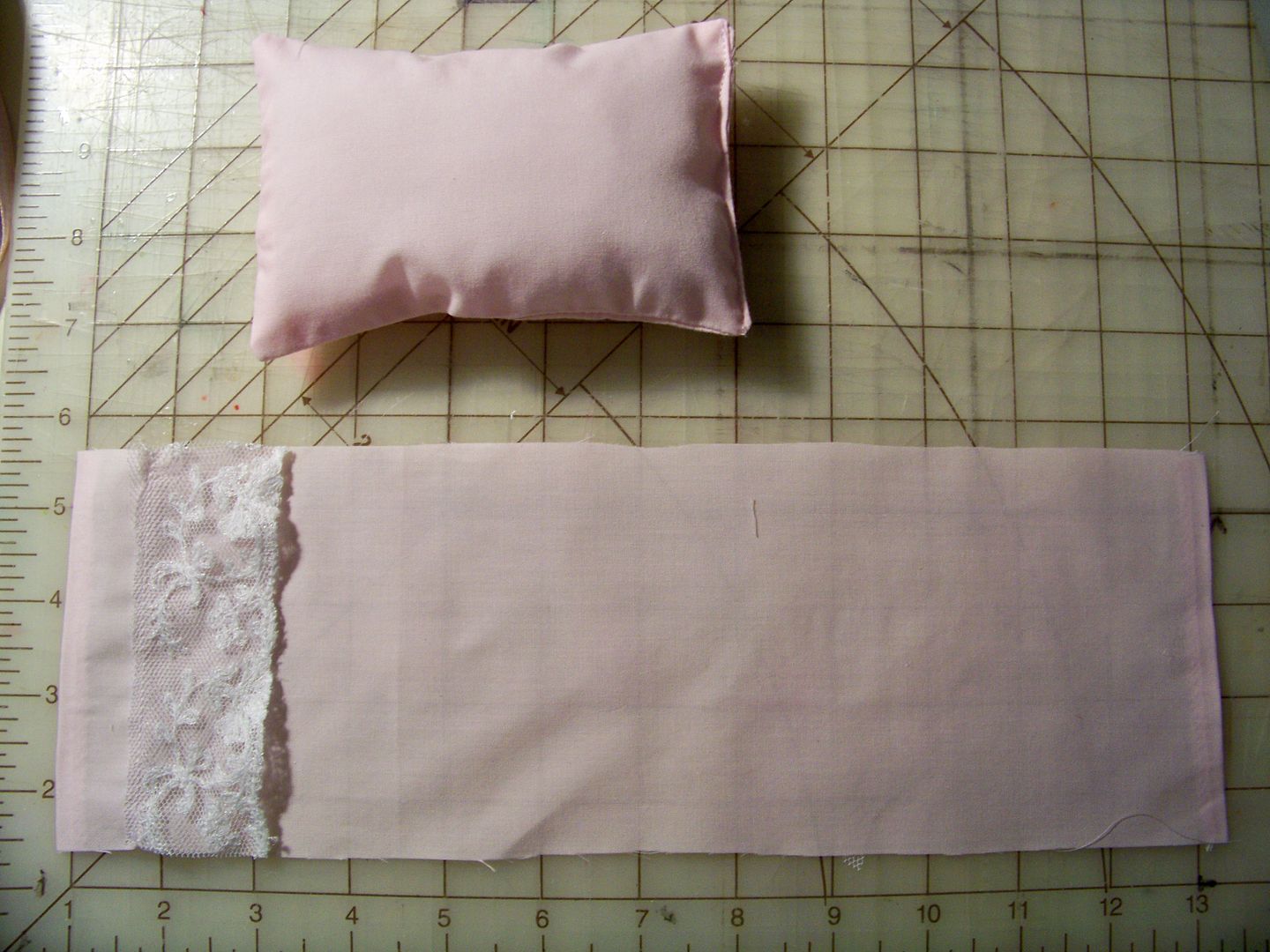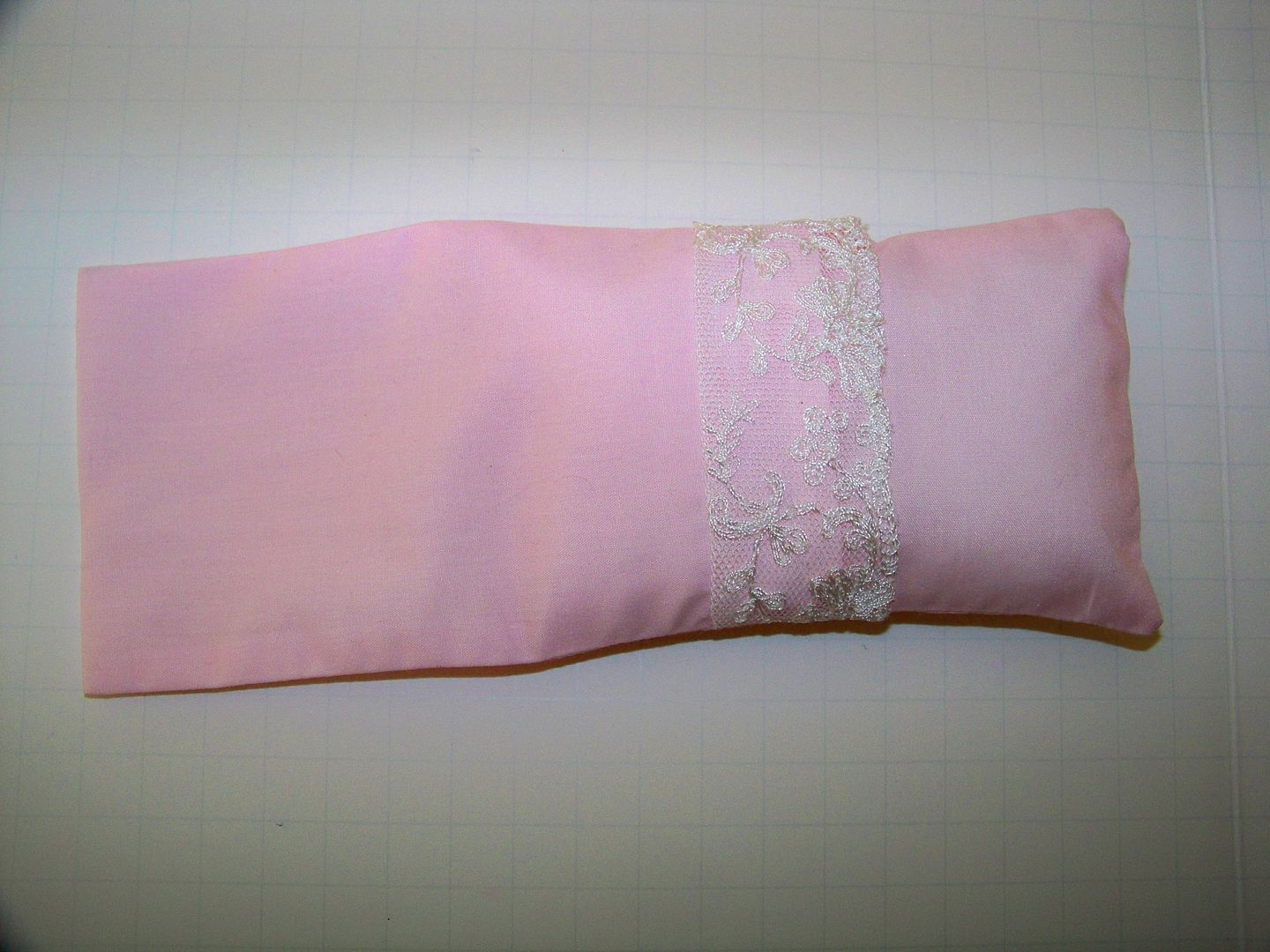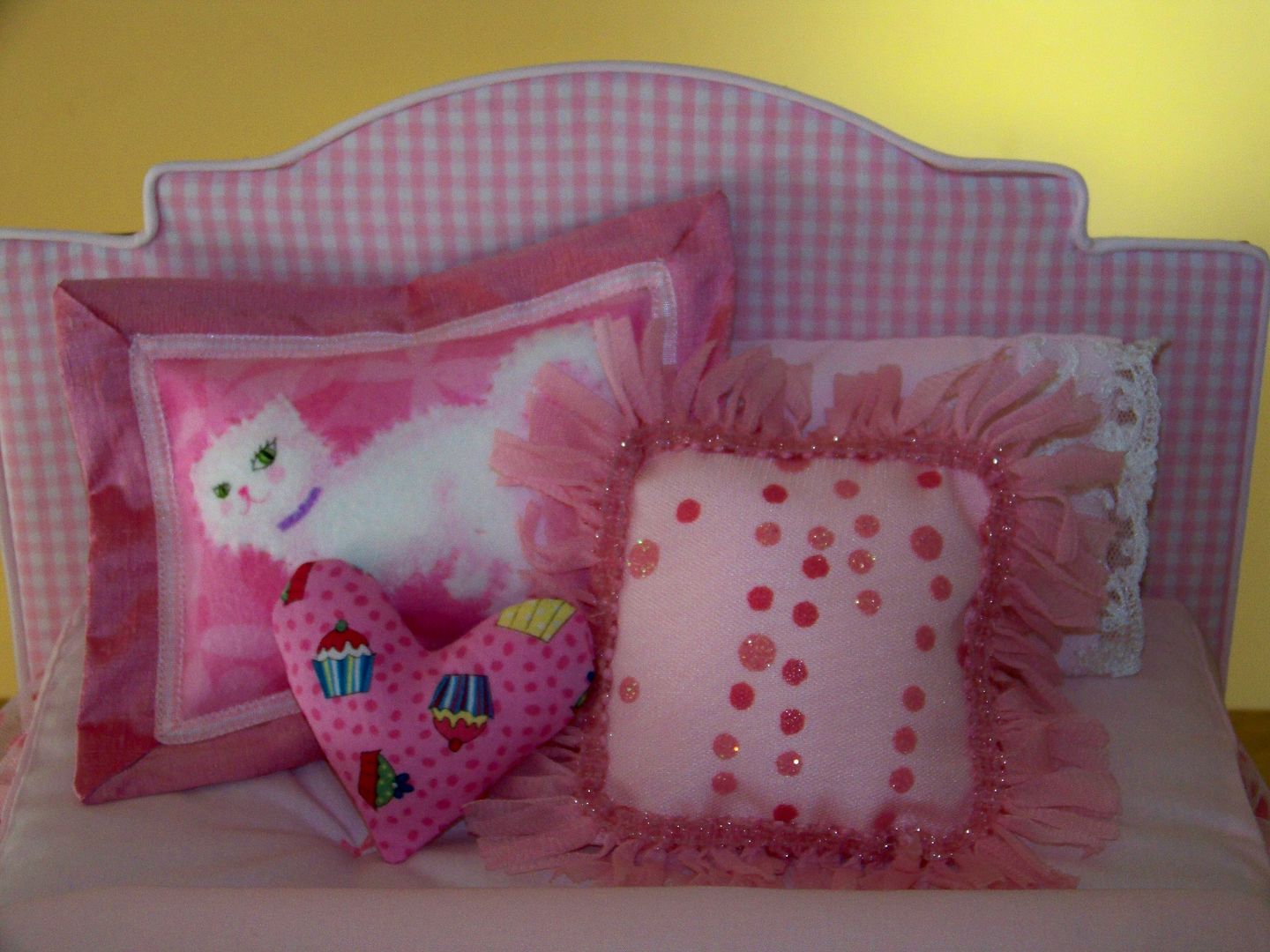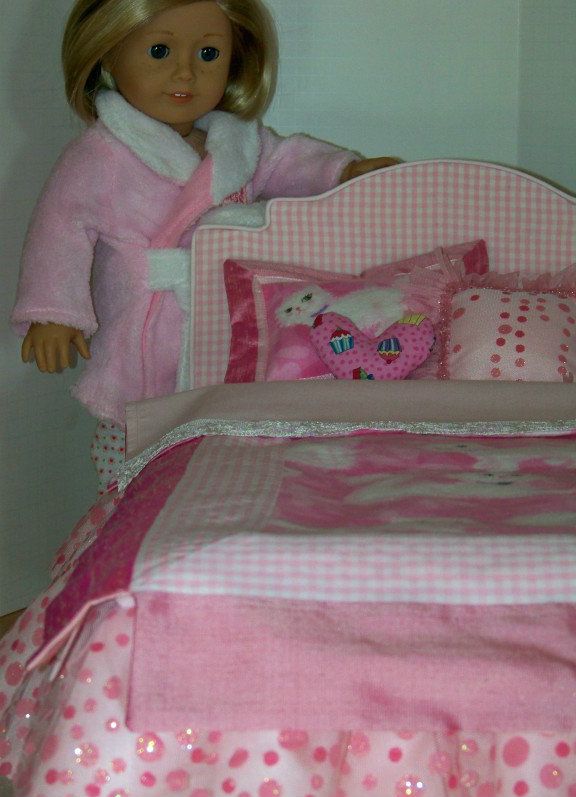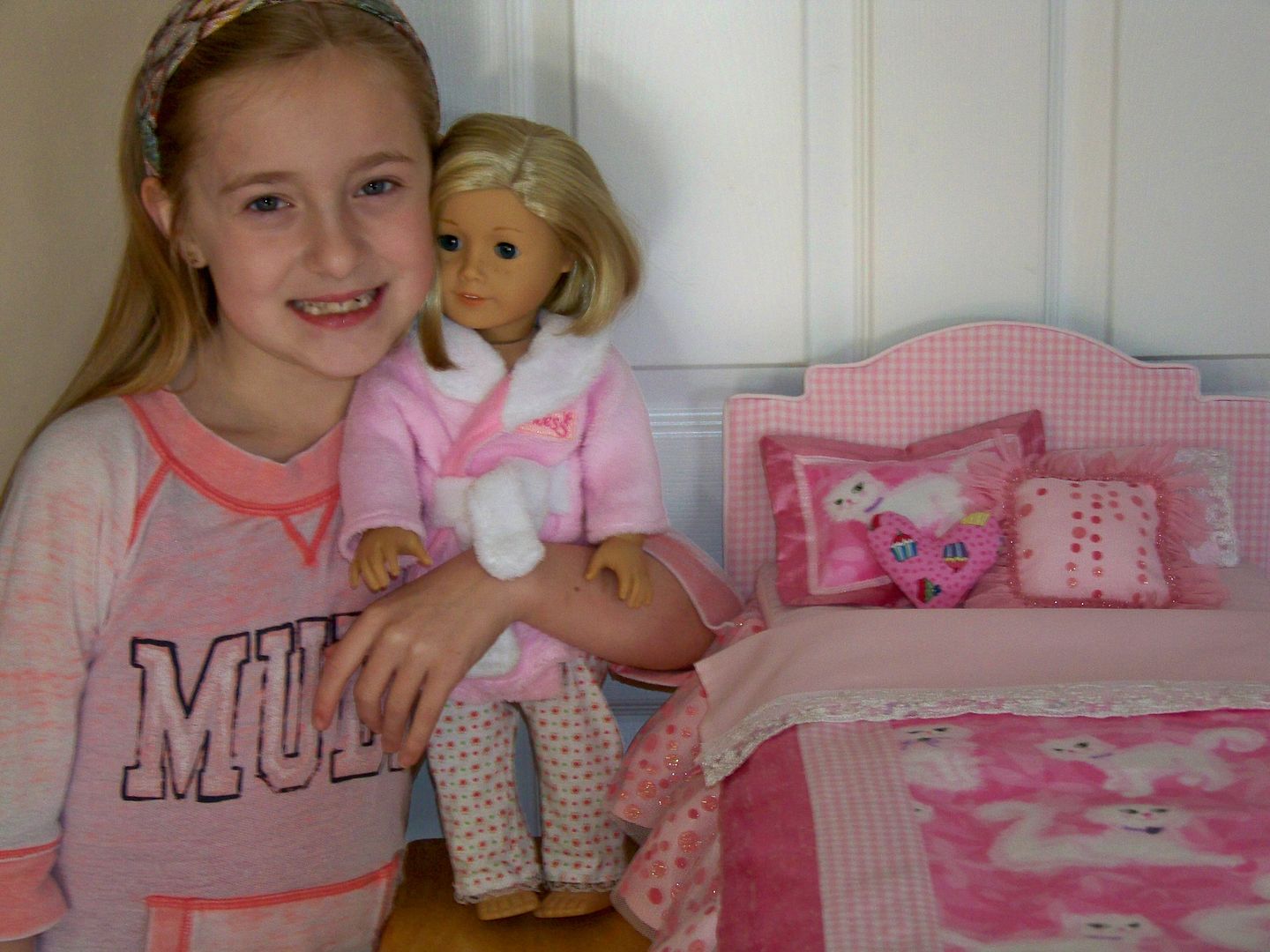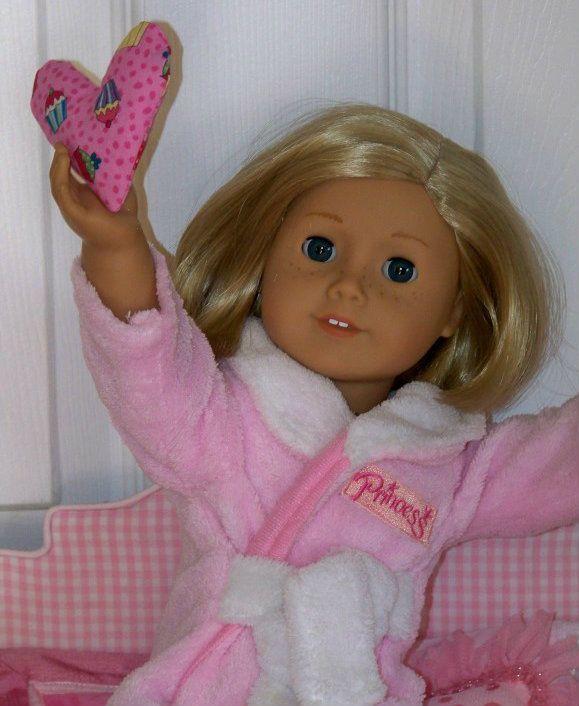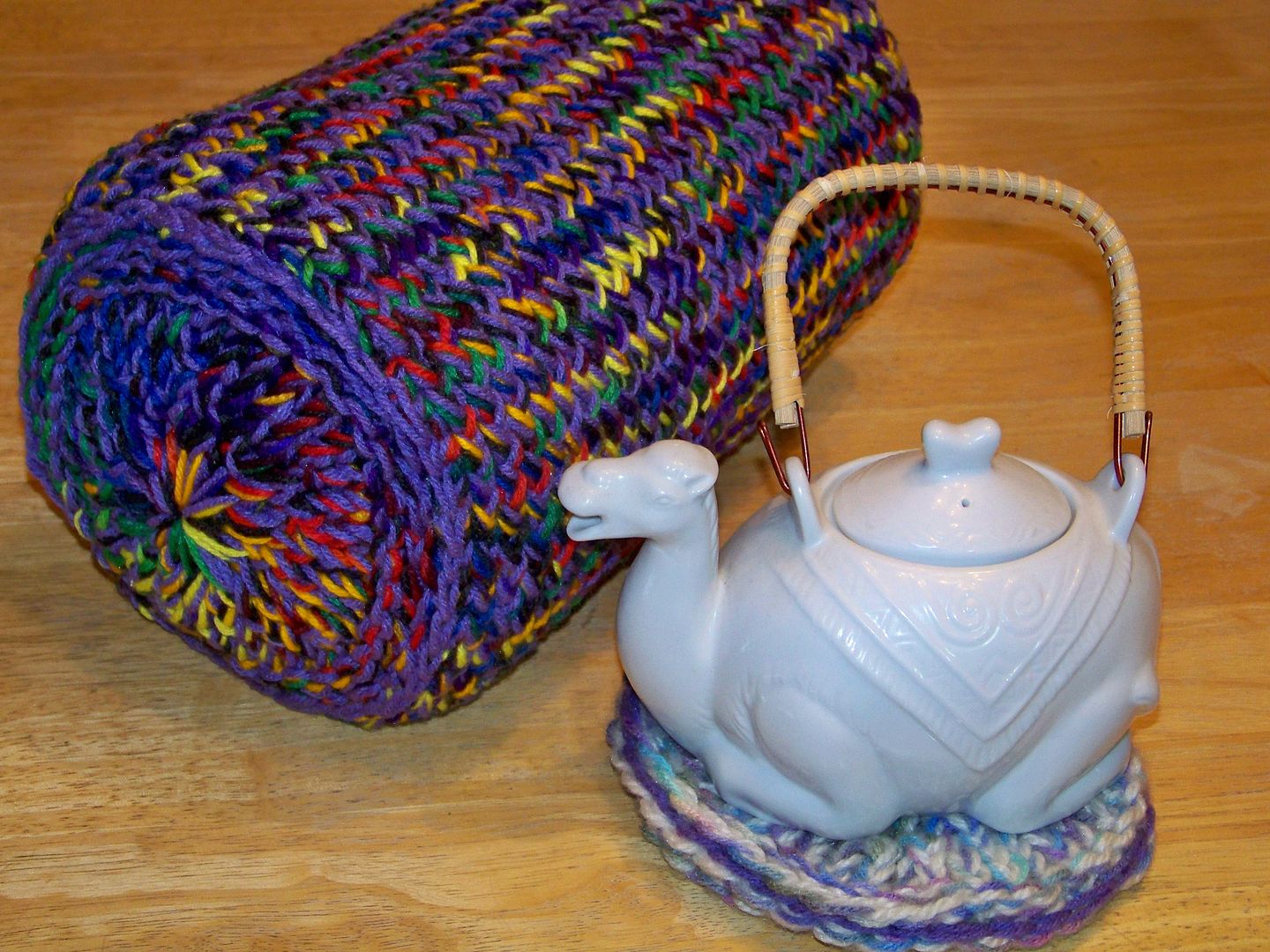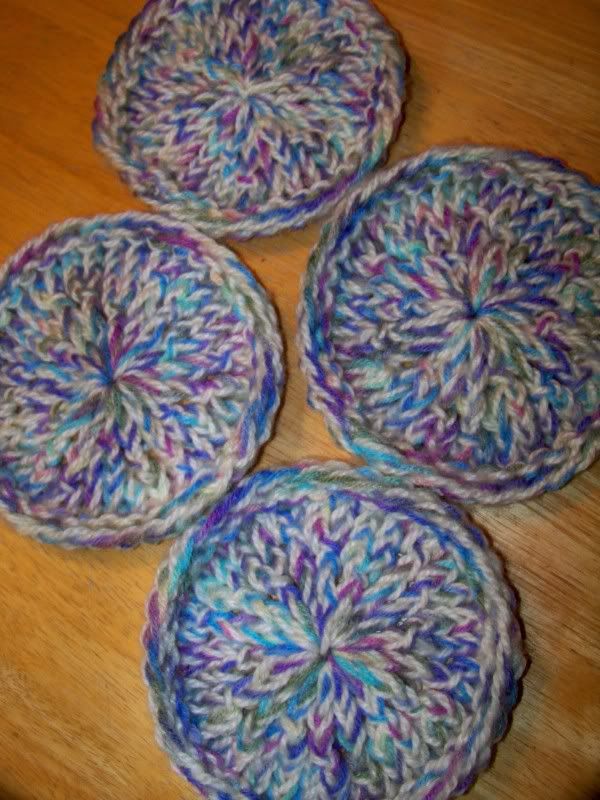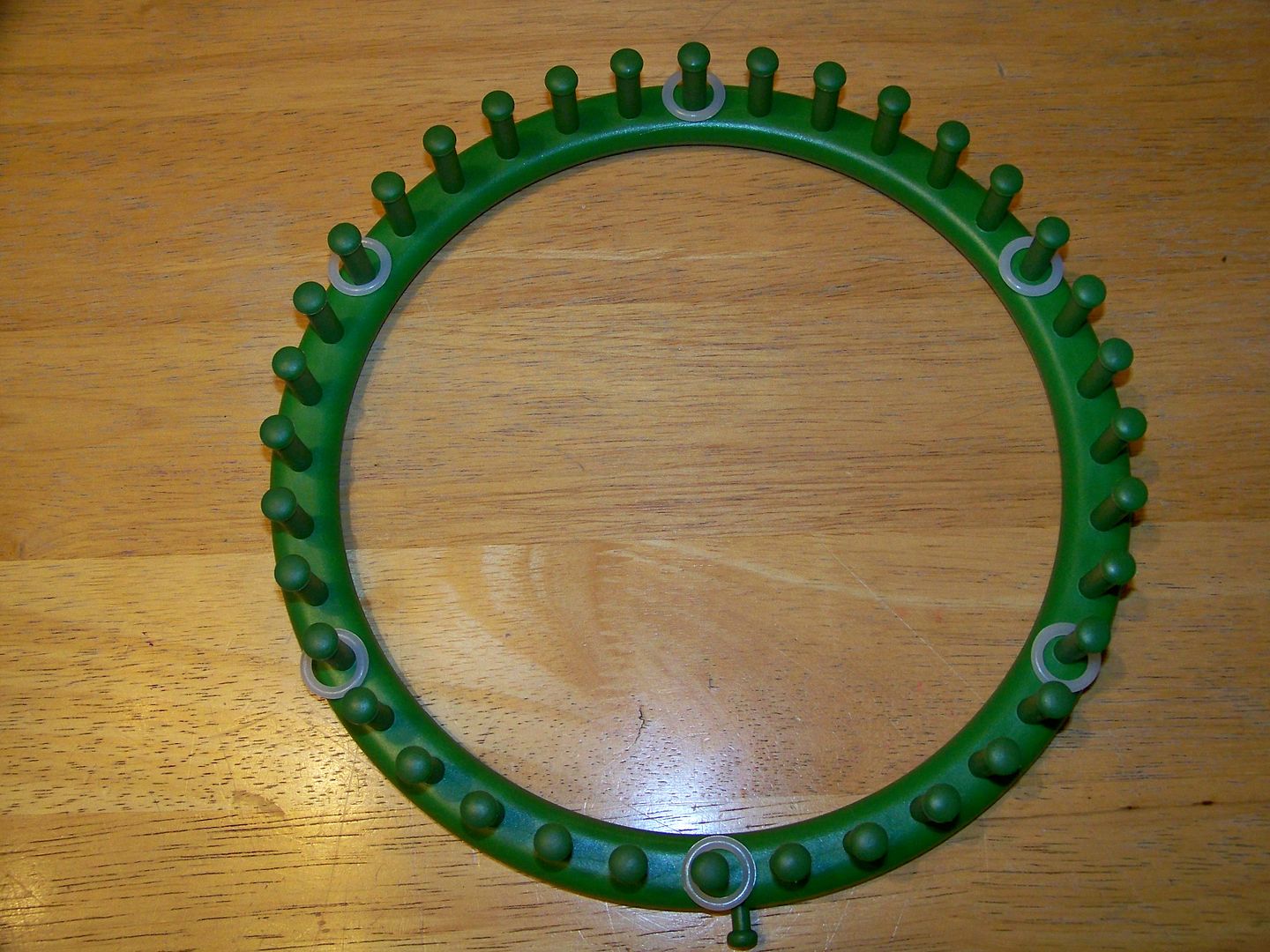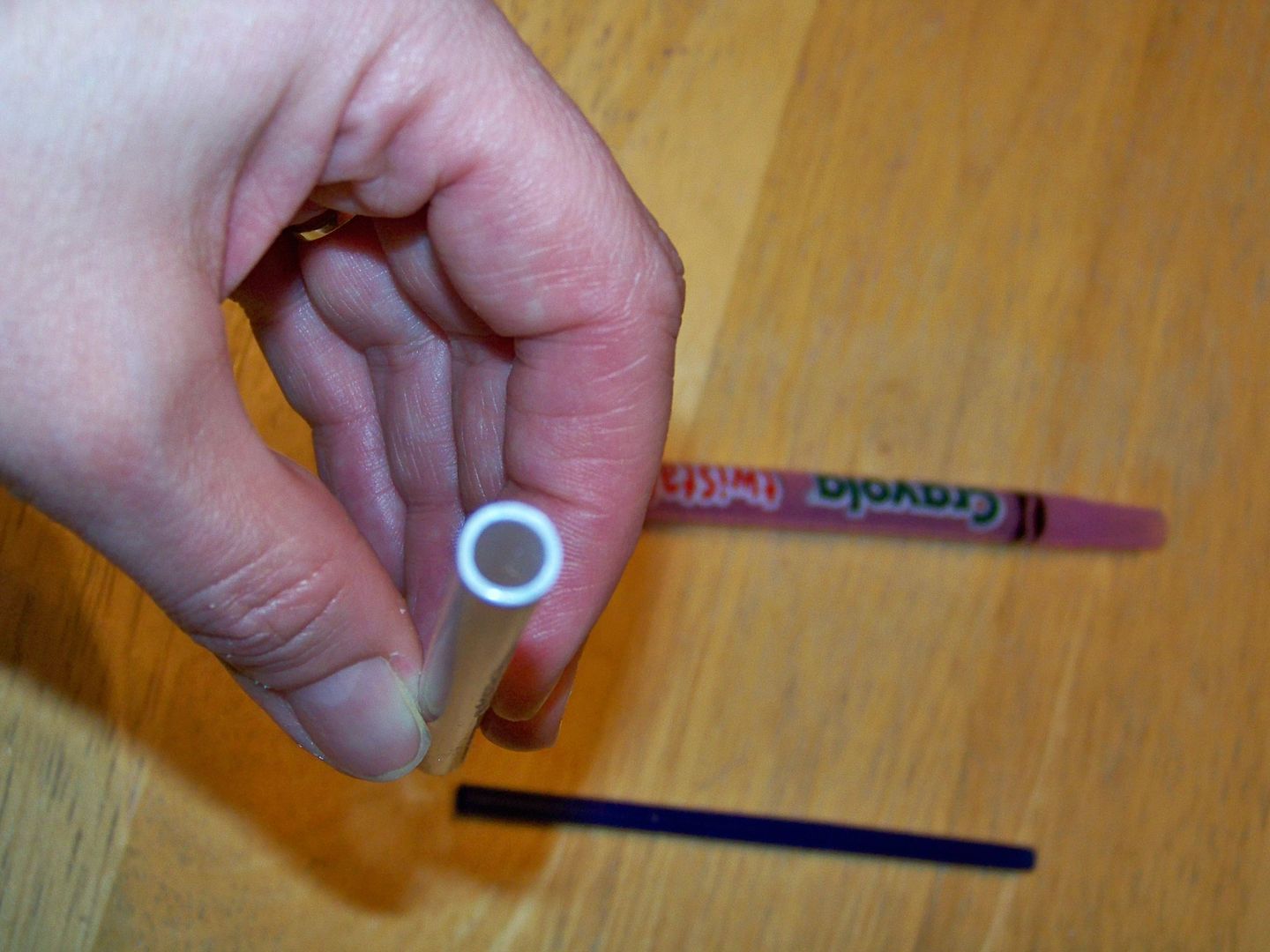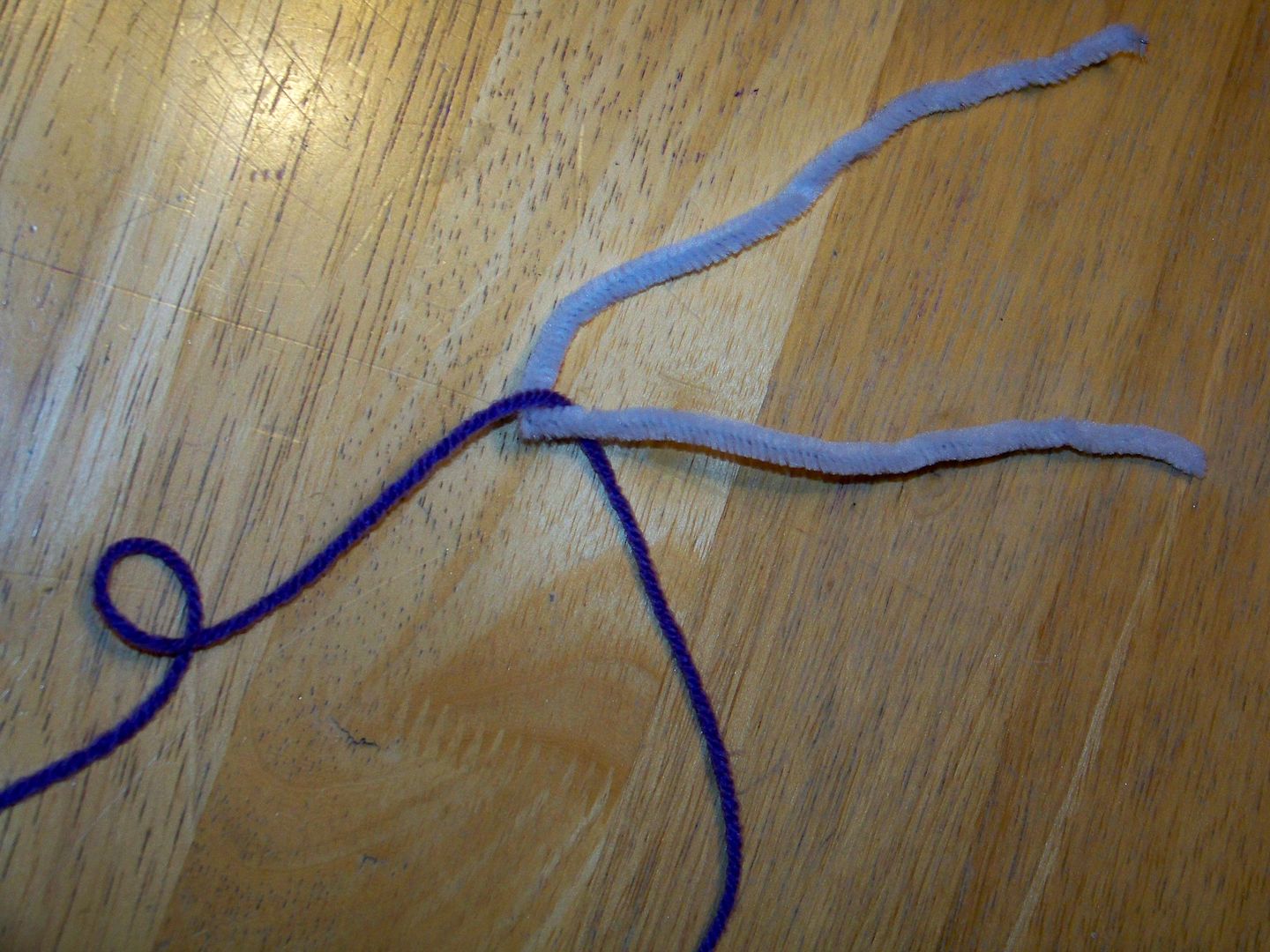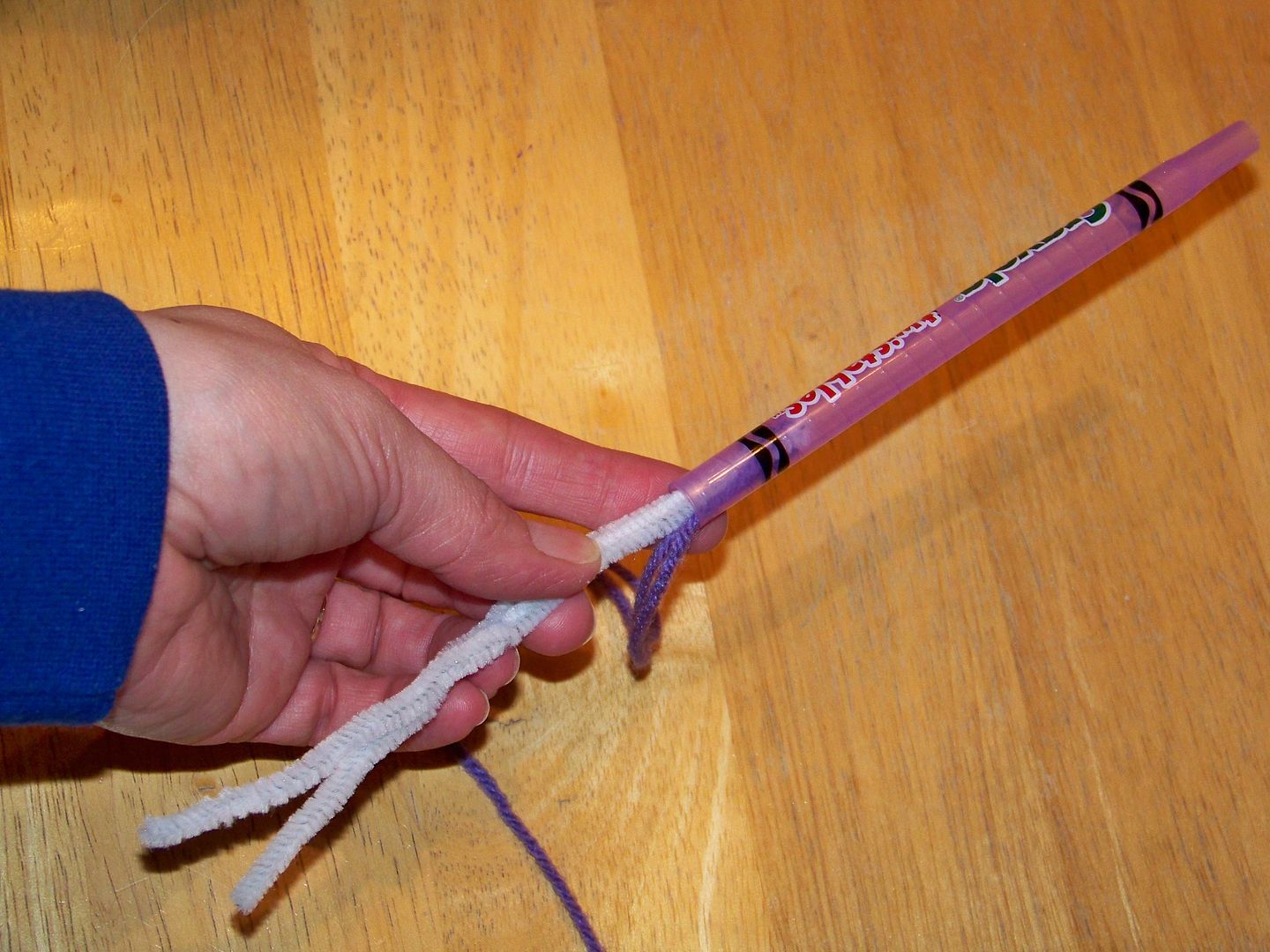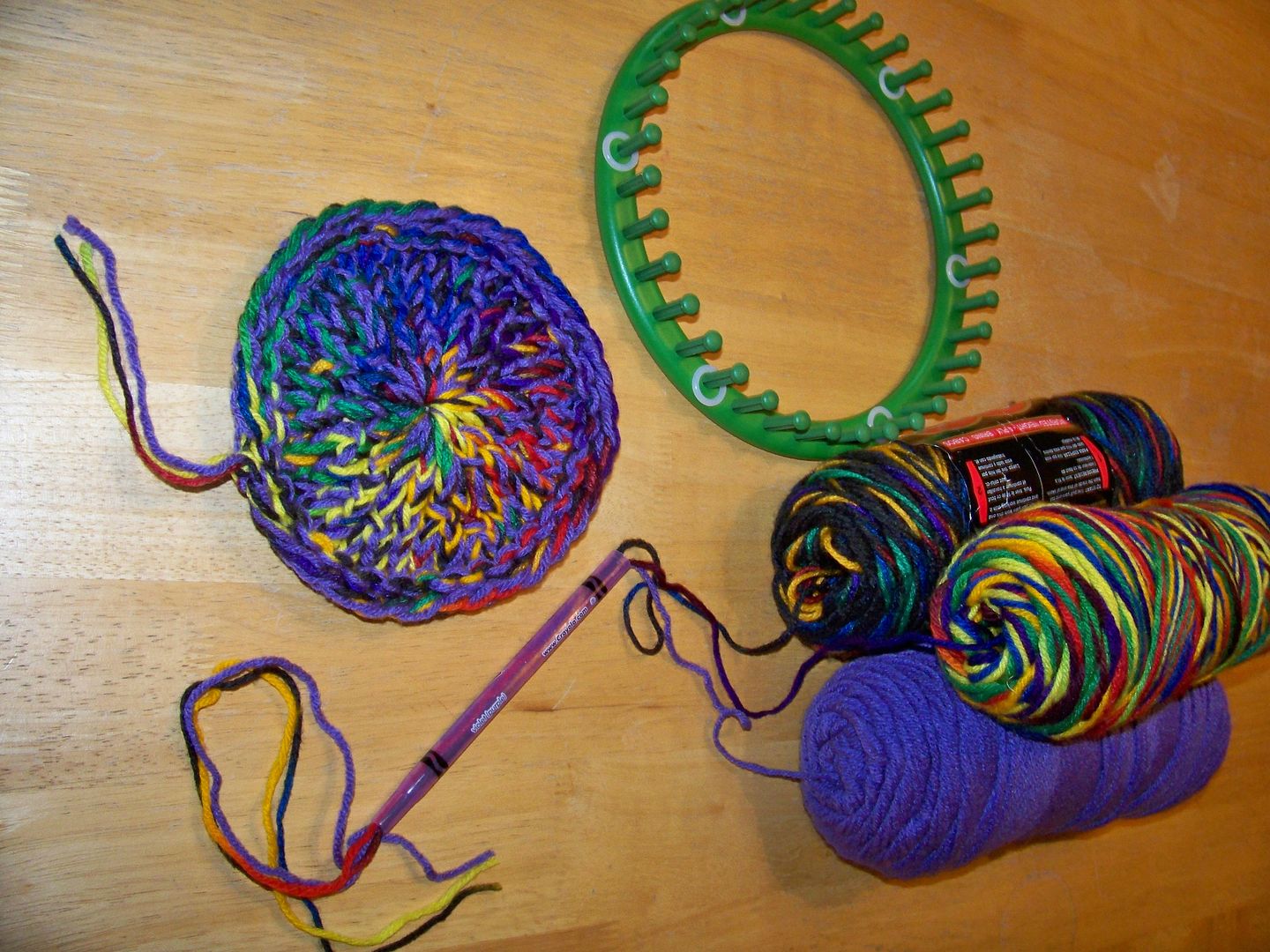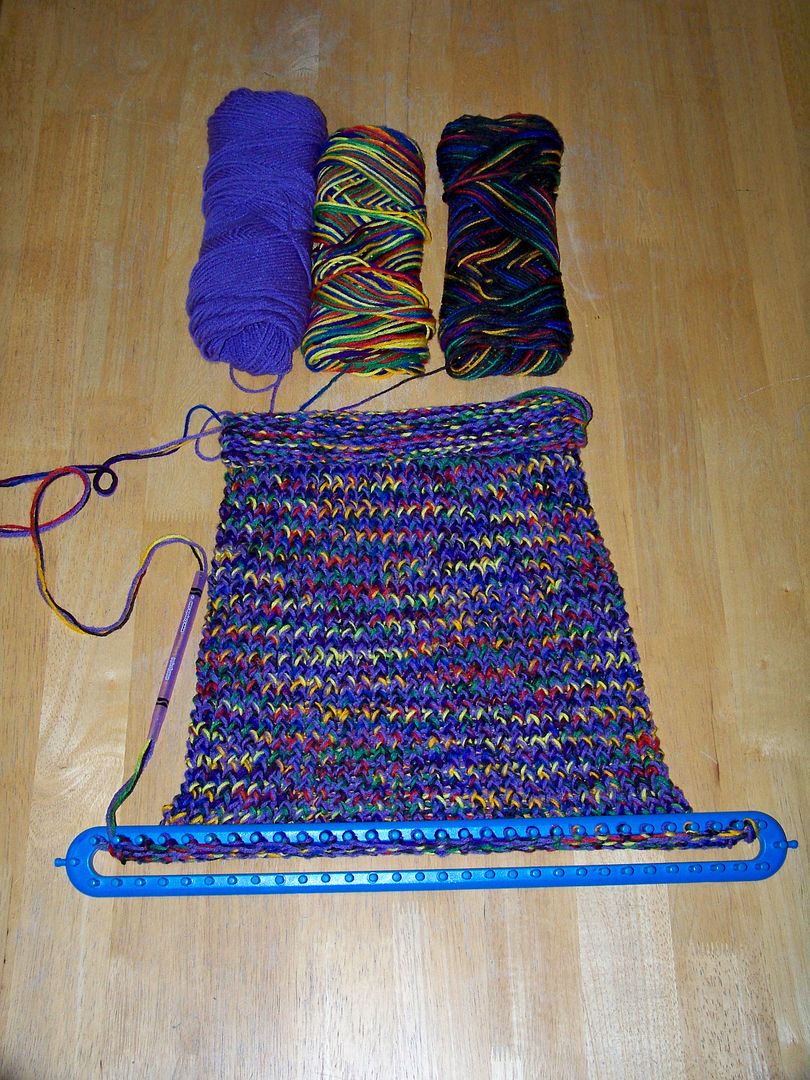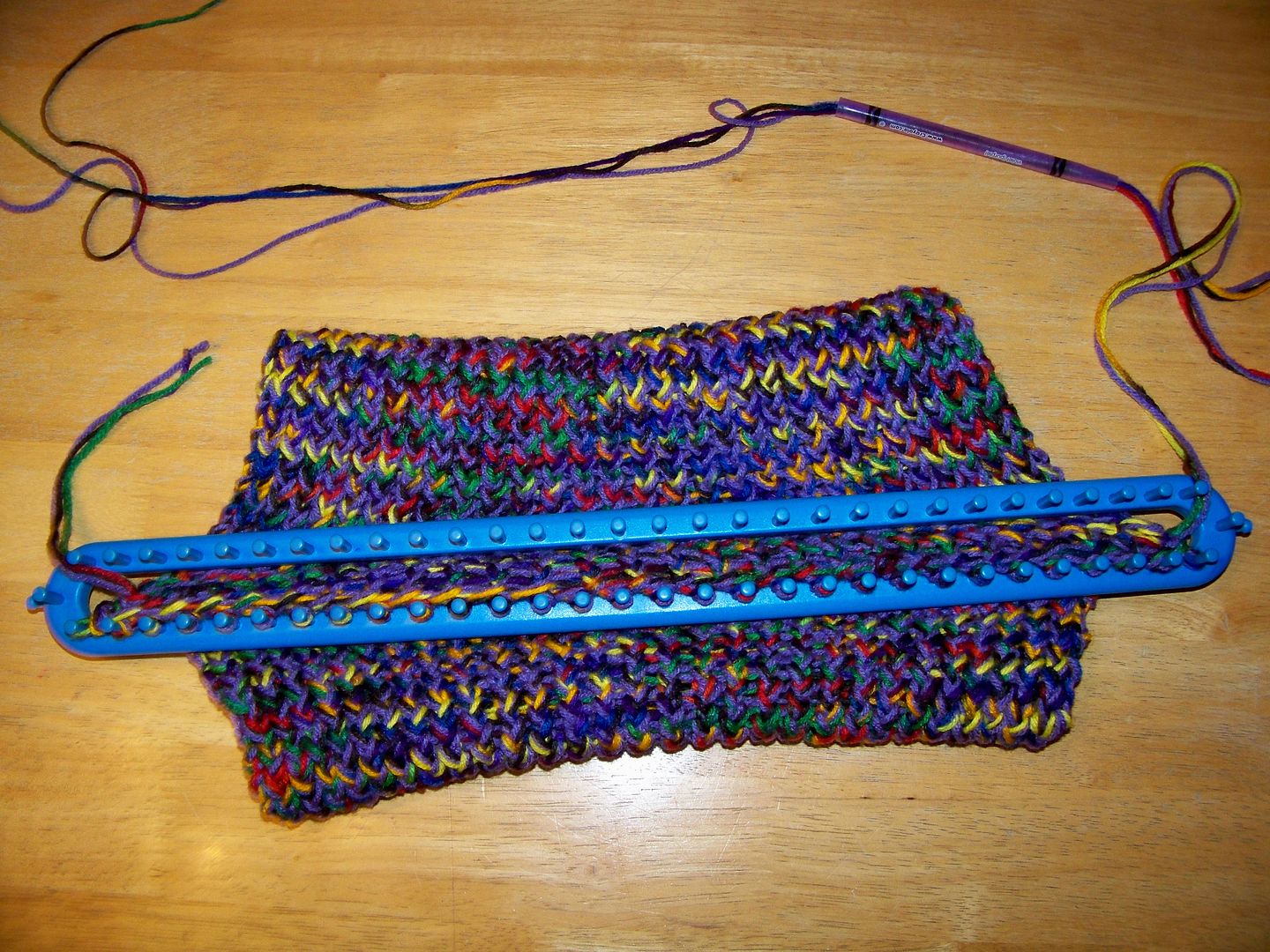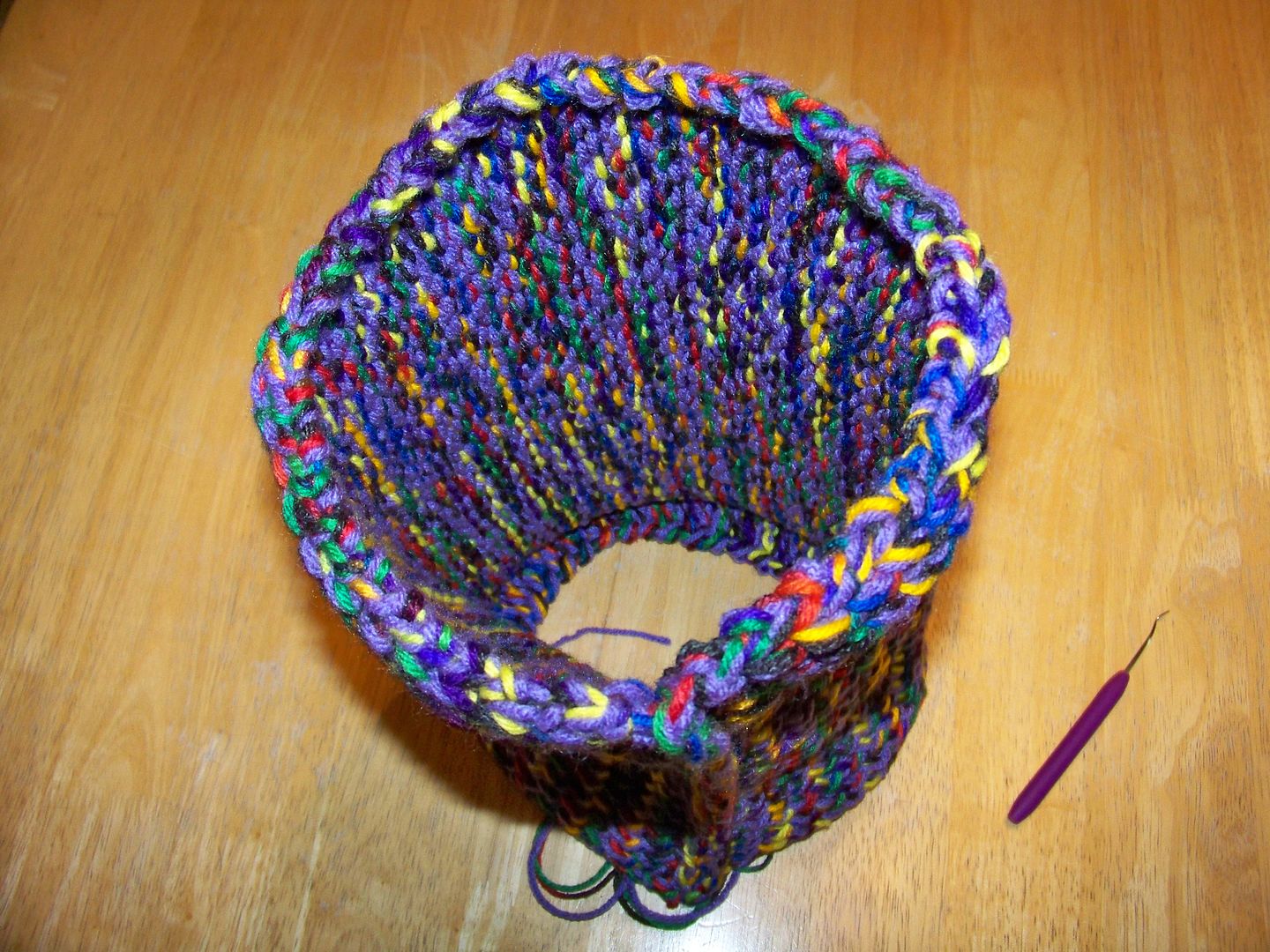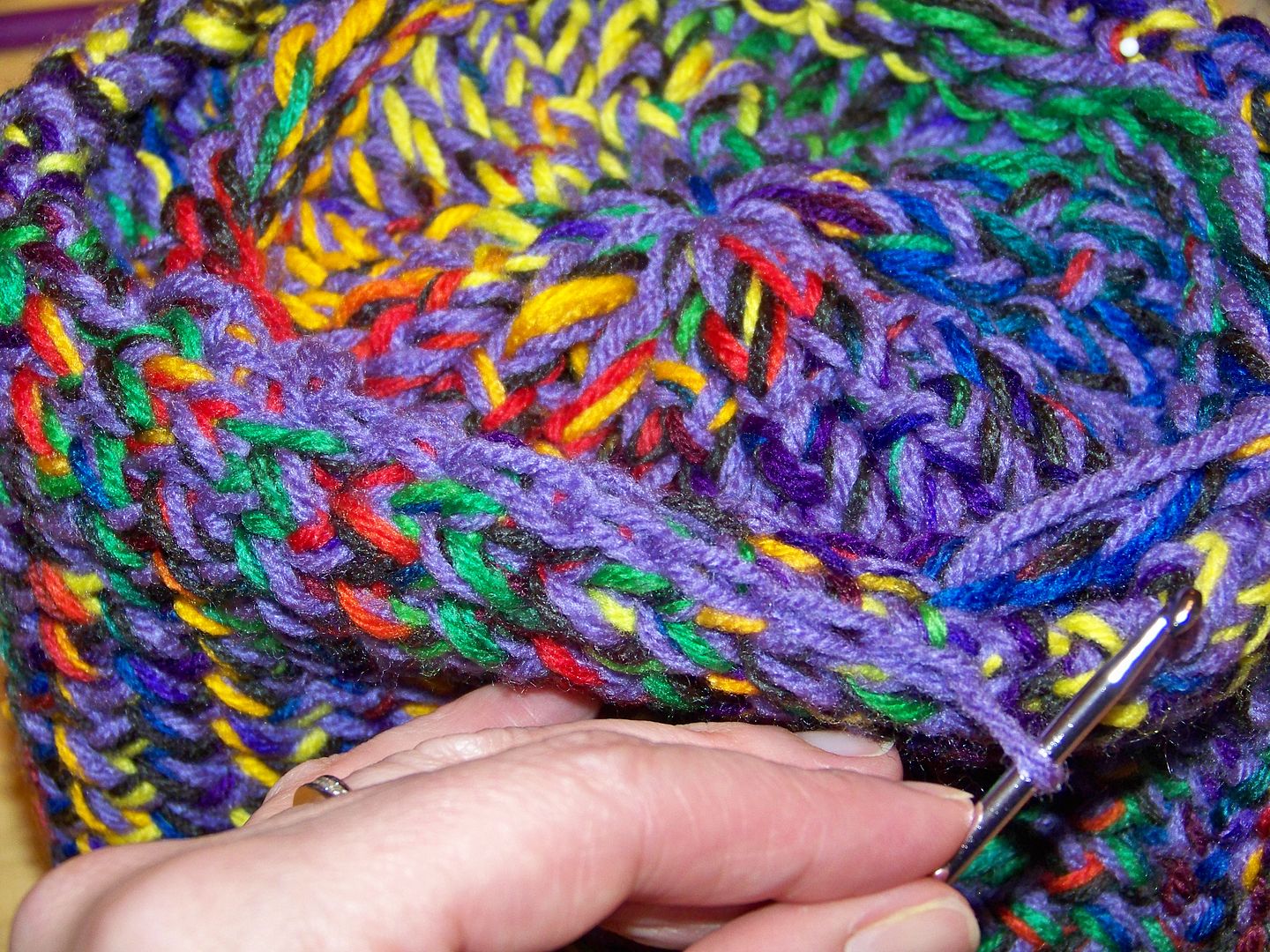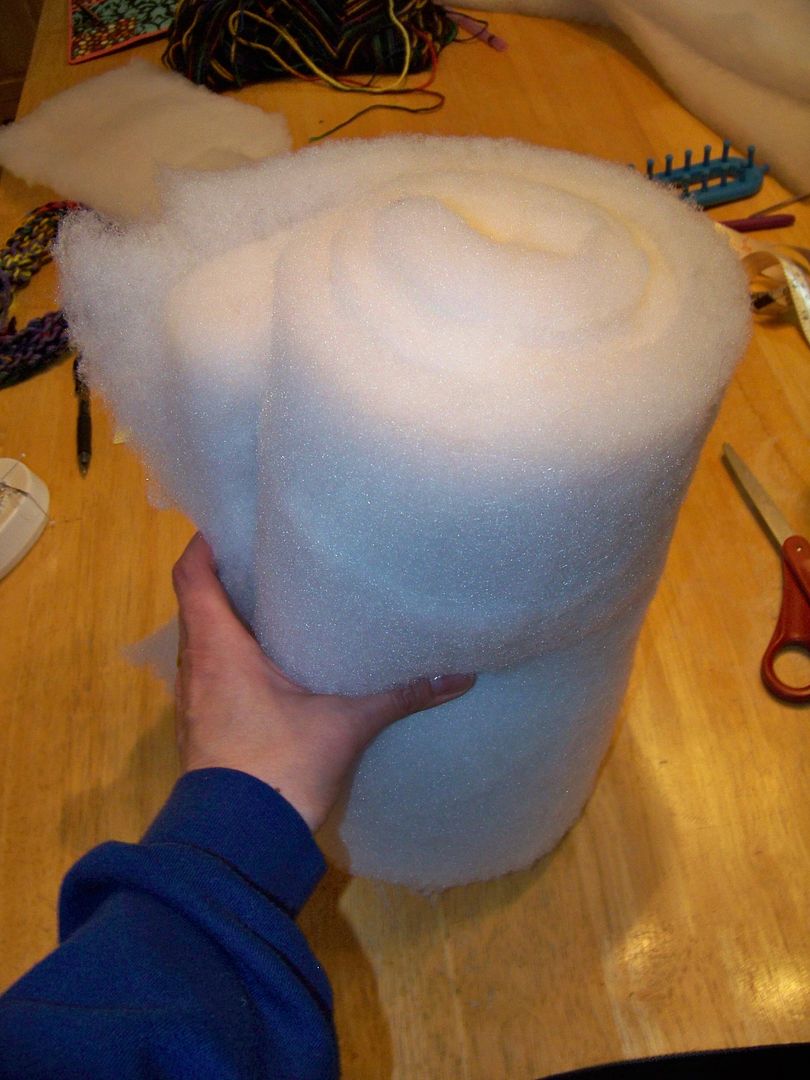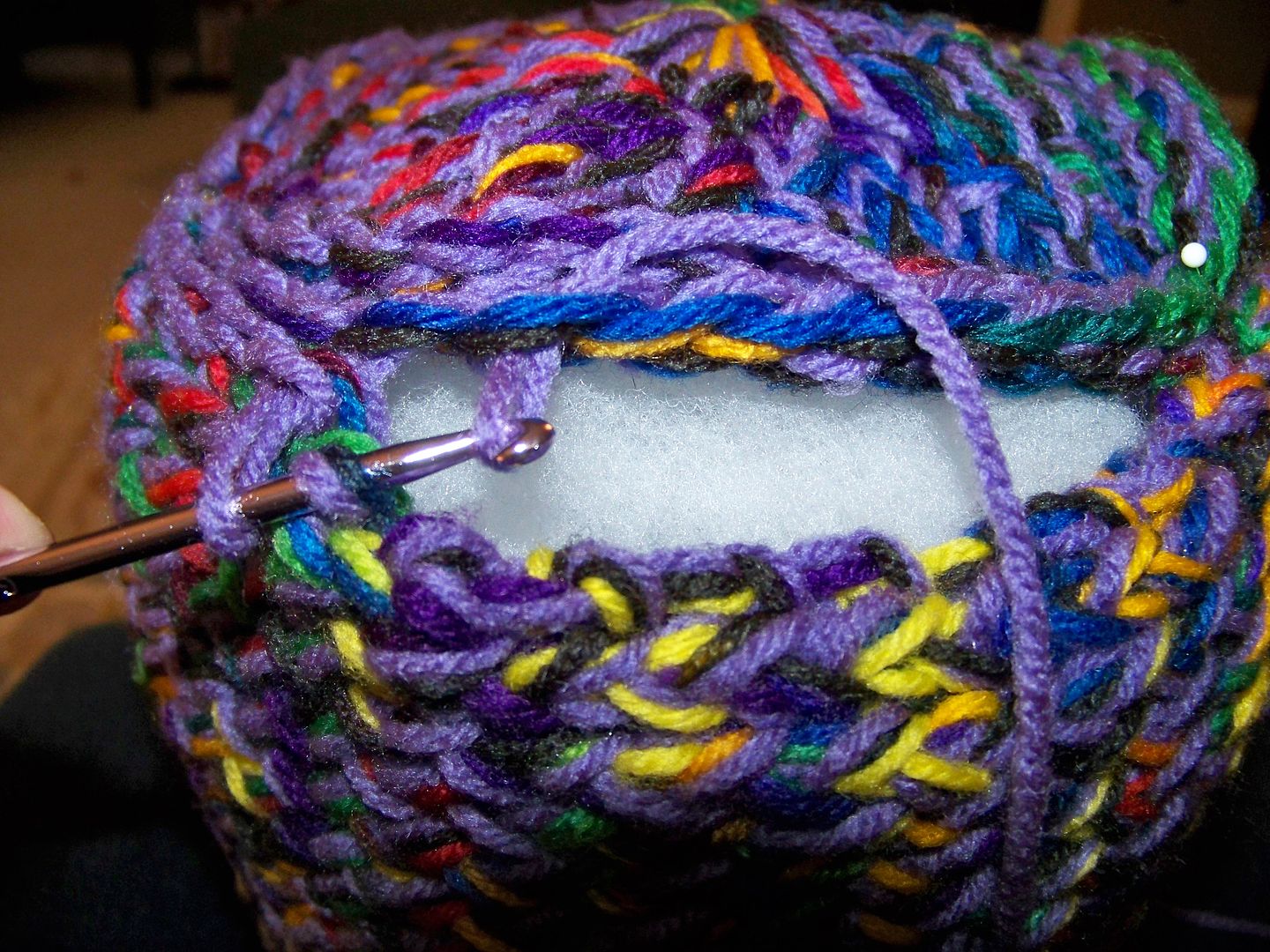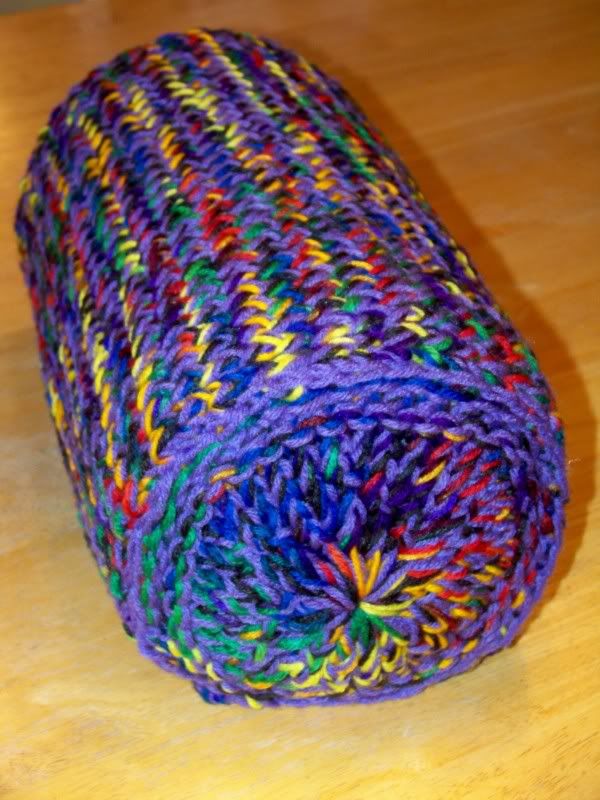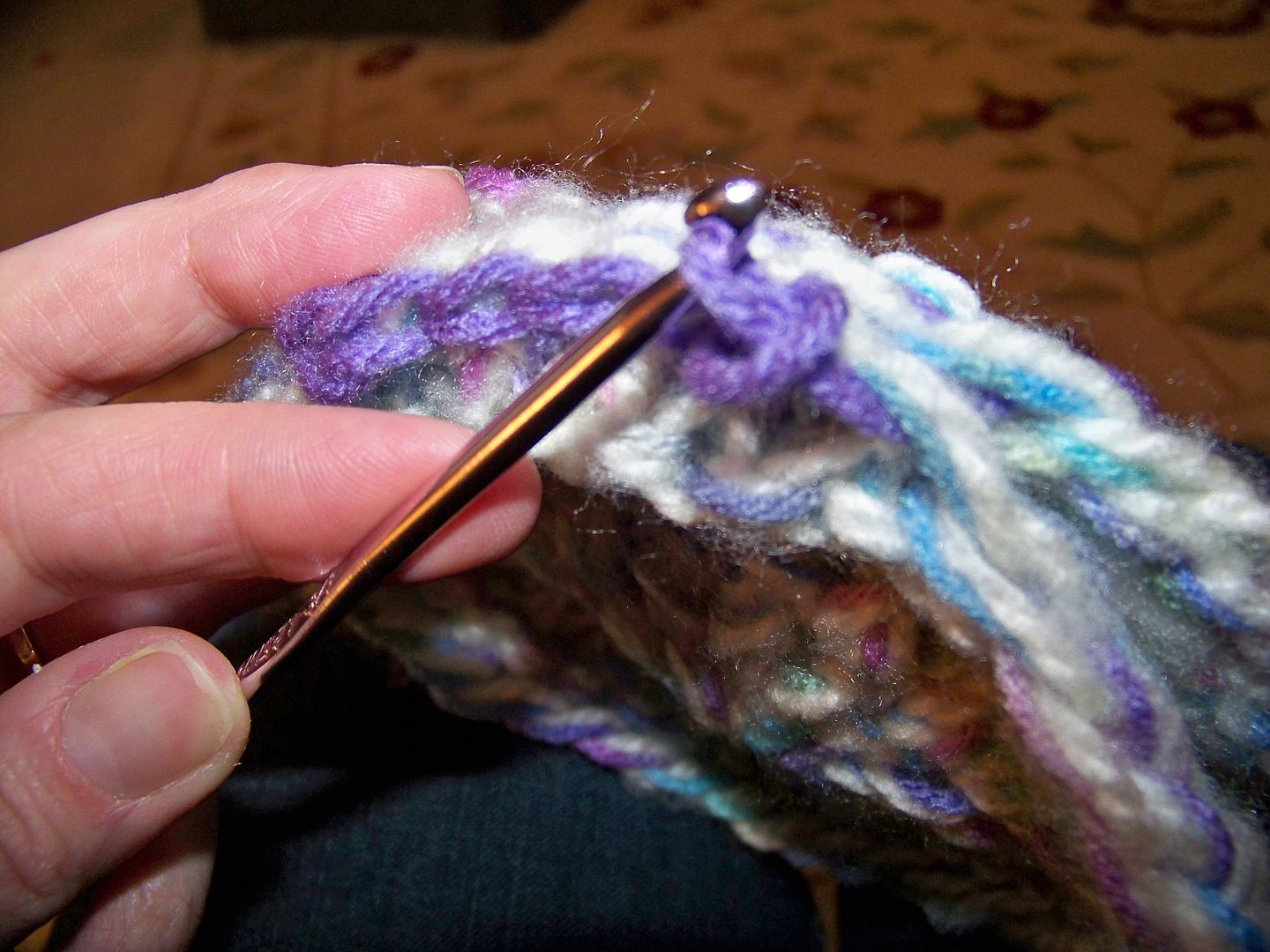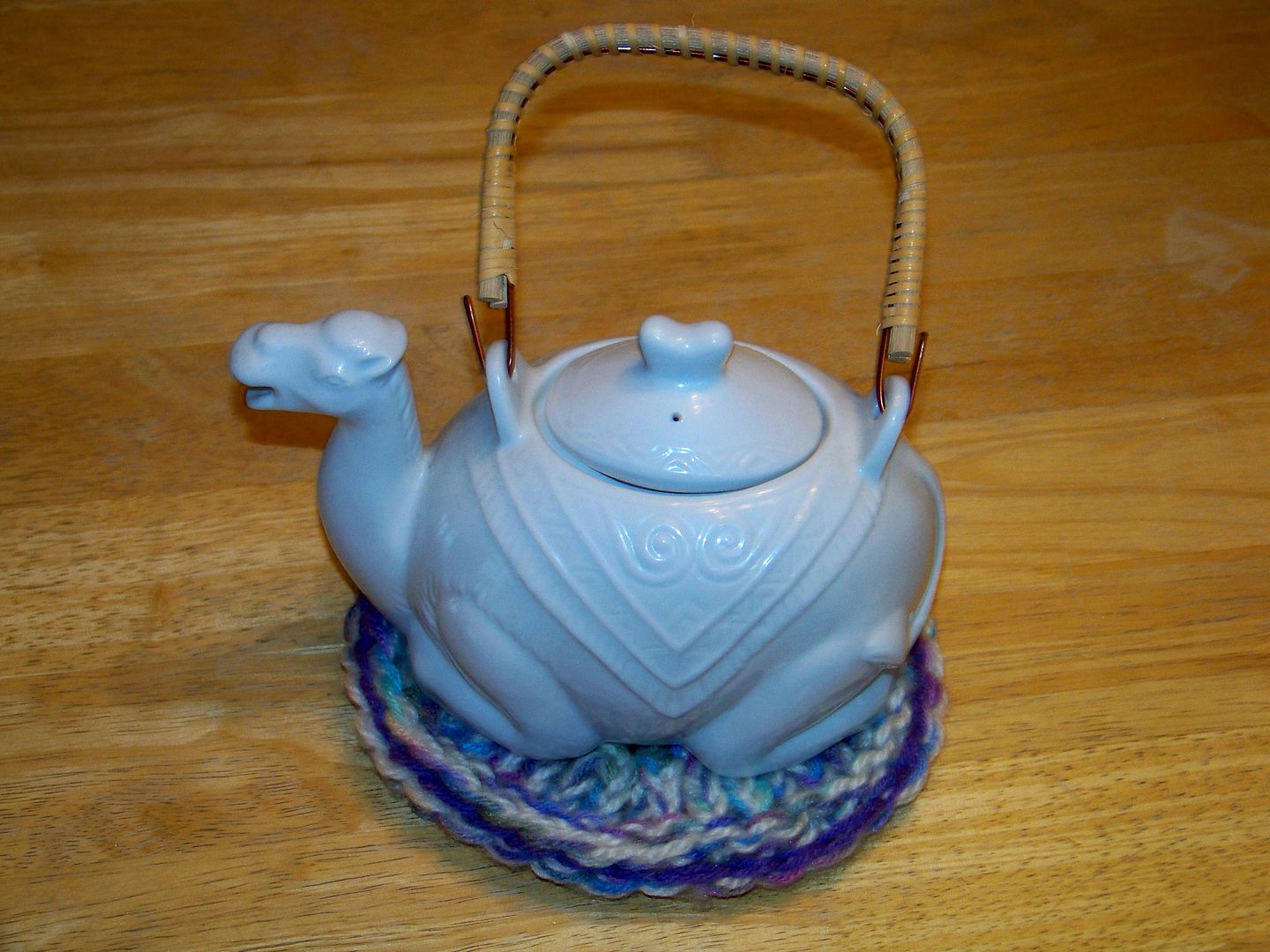 |
| Using my paper-crafting and sewing skills--and my daughter's hand-picked fabrics and trims from my stash-- this is the bed I made. |

I have been wanting to make a doll bed for my daughter's dolls for the longest time. The trouble is that the cutest ones require cutting wood and woodworking. That's something for which I just don't have the tools or talent. (If you do, check out the awesome Doll Farmhouse Bed by Ana White by clicking here.)
I did find a great idea on an out-of print pattern that I have had since before I had a child-- always thinking I would need it I guess. The problem is, it uses a plastic container and a million other little pieces---- it surely is easier to make a bed. The simple ones looked too simple-- and my daughter already had that kind! I wanted to make (using the skills I already have!) a bed that would look as good as the store-bought ones. I recently saw McCall's M6718. This one used a stretched artist canvas as the base! I loved that idea, but not the use of wooden plaques for the headboard and foot-board and not the idea of gluing together chunks of wood from the craft store to make legs as described by the pattern, but at least it was a place to start. I didn't buy the pattern because I wanted to make a padded, taller headboard. (The ones on the McCall's pattern were covered up by the pillow. What's the use of having a headboard if you are going to cover it up!) I used to do lots of home decor sewing so I had my own ideas on bedding-- and my daughter wanted to try her hand at designing. All sewn items used a 1/4" seam allowance; cut sizes reflect that.
The bed frame and headboard...
I started with a 12x24 artist canvas. This was the box springs for the bed! One of the very few things I had to buy for this project was a pair of paper mache letter Es. (These were from Hobby Lobby and less than $2.50 each before the coupon.) They are the legs for the bed!
I used Beacon 527 glue to attach the Es to the 12x24 stretched artist canvas. I used white duct tape to act as clamps to keep them in place while the glue dried overnight. I made sure that one end had the "E" flush to the edge because I would be attaching the headboard there once the glue was dry.
Next, I worked on the headboard. To get the shape of the headboard, I used Cricut Elegant Edges (page 29 'book' feature) cut at "Fit To Page" to get it as large as possible. This was my paper pattern. I transferred the pattern to a piece of Canson Art Board (Drawing). (This is a very dense, strong board and under $5 for a 16x20 piece.) I added 1-1/2" to the bottom and 1" to the sides of the design. I checked the size to be sure I had it about 1/2" wider than the width of the stretched canvas and that it would be tall enough once the canvas was supported by the Es. The bottom of the headboard touches the floor. I hand-cut the shape with an Xacto knife.
I padded it with cotton quilt batting. This has been in my stash since 1994 according to the price tag. I was happy to use it! Ha!
I cut it the same size as my art board headboard.
I cut decorative fabric about 1" larger and clipped at all inside corners and trimmed off all outside corners before hot gluing to attach the fabric. Then I glued on a little piping to define the edge and to make it look a bit more finished.
I cut a piece of brown paper that I glued to the back to finish it and to hide the raw edges.
Once the glue was dry that held the Es onto the stretched artist canvas (I allowed it to dry overnight), I used the same glue to attach the head of the bed to the headboard. I didn't paint the Es but later in the project, I ended up using white duct tape to cover then. Next time, I will do that before gluing them in place!
I allowed the glue to dry for a few hours, then I used my staple gun to staple the headboard to both the stretched artist canvas and to the legs.
I stapled square pieces of hook-side Velcro to the corners of the top of the canvas. This will aid in keeping the bed skirt in place-- the bed skirt will be a later step!
The mattress...
I knew I would just make a box-style pillow for the mattress. Oh, how I wished I had pink pillow ticking! My daughter picked a cotton broadcloth from the stash. I cut two pieces of broadcloth at 12-1/2 x 24-1/2 and pieces to make 1-1/2" x 73" to make the sides. I used dacron batting for the inside. Dacron is upholstery batting-- thicker and sturdier than quilt batting. The batting was cut at 12x24.
I just attached pieces end-to-end to make the long 73" strip. (Scroll down to the info on the bed skirt to see how I figured our how many pieces-- it is the same method-- if that is of interest to you!) I sewed the strip to the mattress top, clipping at the corners to turn. I sewed the mattress bottom on, leaving a 6" area unsewn so that I could turn it right-side out and place the batting inside.
I find that if I iron to form the corner creases (before putting the batting in), it looks more like a box!
I placed the batting inside, slip-stitched the opening closed, and made thread tacks to keep the batting in place.
The mattress gets placed on top of the bed skirt!
The Bed Skirt...
I created a decking and attached to it, a gathered, 2-layer ruffle to make this bed skirt. The top ruffle is sheer netting; the bottom ruffle is tightly gathered poly taffeta.
I had planned on a 5-3/4" drop after measuring the height of the bed from the top of the canvas.
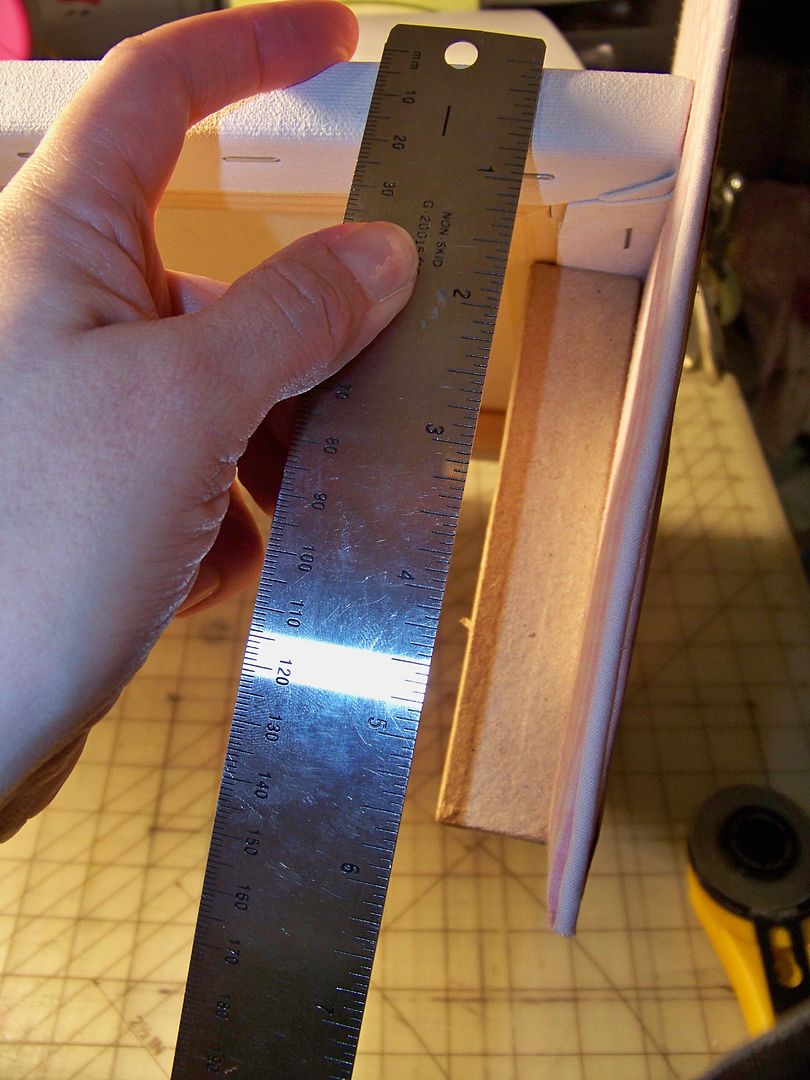 |
| Measuring the drop. |
I really could have (should have?) allowed for a longer drop since I was using poly taffeta for the lower ruffle and since I was gathering so tightly! Live and learn. Because of this, my bed skirt (dust ruffle) doesn't touch the floor and the bed legs show a little bit.. At the point that I was finished with the bed skirt, I did go back to my bed frame and wrap the Es (legs) with white duct tape. It was an easy solve, but next time, I will take the body of the fabrics in this tiny size more into consideration (or perhaps do a pleated skirt) so that it will touch the floor!
Enough of that... I measured my stretched artist canvas to find that it was actually 11-3/4" x 23-3/4". Due to that, I cut my decking 12-1/4" x 24-1/4". I finished the top edge by serging and turning under 1/4" and top stitching.
I cut strips of poly taffeta (the bottom ruffle) and sewed them end-to-end to create a piece that was 6-1/4" x 150". I hemmed the bottom edge.
If you are interested in how I figured this size, here's a quick lesson. I used to do this for a living and loved helping people figure out how much fabric they needed for projects for their dream home!
- Add the lengths of the left side, bottom, and right sides of the stretched artist canvas. (The ruffle only goes on those three sides, not the head.) For me, that was 24" + 12" + 24" = 60".
- Multiply that number by the fullness you want. The standard for normal home dec is 2.5. For dolls, I probably should have reduced that number, but I did not. For me, that was 60" x 2.5 = 150". Now you have the total length of fabric you need to gather up.
- Since you won't want to cut one, big, long piece of narrow fabric (that would be almost 4-1/4 yards), the preferred way to do this is the cut several lengths and sew them together to form the long piece. So, divide that number by the width of your fabric. For me, that was 150" / 60 = 2.5. For decimals, you go to the next whole number so I will need 3 cuts. Then measure your drop. For me, that was 5-3/4". I added 1/2" to this to allow for my upper seam and lower hem to get 6-1/4". Multiply your drop (with seam and hem allowance) by the number of cuts you need. For me, that was 6-1/4 x 3 = 18.75". If I were going to buy fabric. I would need that much fabric (bump to 5/8 yard since it is slightly over 1/2 yard.) Since I am using my stash, I knew I needed to make three cuts that were 6-1/4" long.
For the top ruffle, I only had a short piece and I wanted to use the border only. Luckily, this one had border along both sides of the selvage so I just cut for the drop I needed and gathered what I had (about 60" of border). This is a netting with ink dots printed onto it and glitter adhered. I chose not to hem the bottom so that the hem would disappear.
To gather almost anything, I zig-zag over a thin cord (I have a spool of perle cotton that I use for gathering). Then I just pull up the cording and voila! Super easy, super fast gathering. (For netting, I break my rule and use one row of long machine basting stitches).
I gathered the top ruffle and put it face-down on the decking (ie. right-sides together) and pinned. Then I pinned my bottom ruffle, also face-down. I sewed around all three edges.
I serged the seam to finish and sewed squares of the Velcro loop to the underside of the decking.
I placed the bed skirt on the bed, catching the Velcro squares to each other. The mattress was placed on top of the bed skirt decking.
The coverlet...
The coverlet I made was a block of a patterned fabric, bordered with a smaller pattern with mitered corners. I added flaps that hang on the sides from a solid. I used flannel (leftovers from a nightgown I made my daughter a few years ago), gingham (left over from baby shower table cloths I made), and silk dupioni (from a remnant I bought almost a decade ago). This is what makes sewing for my kiddo's dolls so much fun!! You could never get away with those together on a real bed to be used by discerning people!
The cat print was cut at 22-1/2" x 8-1/2". The gingham border was cut 2-1/2" x 24-1/2" for each side and 2-1/2" x 12-1/2" for the bottom. The silk flaps (drops) were cut at 3" x 24-1/2" for each side and 3" x 12-1/2" for the bottom. I cut a piece of poly taffeta for the bottom by simply placing the pieced and sewn coverlet top face-down on the backing and cutting out. I did not use a batting with this. I stitched all sides except for the top edge and turned it right-side out and pressed. I serged the top and turned it under 1/4" to finish.
Sheet...
Well, I wanted the bed to be pretty when it was turned down, so I made a quick decorative sheet from broadcloth. I cut it at 16" x 24". I serged all sides and turned them under 1/4" and top stitched to finish. I sewed a piece of Schiffli lace to the top edge, face-down and about 1" from the top. I folded it up and pressed in place. (I used to work at a fabric store with a bridal department of imported laces. They would sell end cuts of Schiffli, Alençon, and Venice laces in grab bags. I had to have bought that grab bag 20 years ago-- about time to use some of that lace, huh?)
The key to this is to remember to teach your daughter to lay it pretty-side down on the bed (just like you do on your own bed) so that the trim shows when it's turned down.
Pillows!!!
Well, what made this extra fun for my kiddo to design were all the pillows.
Pillow sham...
The pillow sham was made with the same flannel (cat print) and silk (solid) as the coverlet. I used a pink gingham ribbon instead of sewing in a border. The fun thing about this (and this whole bed project really) is that you can get fancy or keep it simple!
The center was cut at 6" x 4-5/8". The flanges were cut at 1-1/2" x 9" for the top and bottom and 1-1/2" x 7-5/8" for each side.
I hand-quilted around the cat with a bit of cotton batting underneath for a tiny bit of loft before adding the silk border with mitered corners.
I top-stitched the ribbon trim. I placed it face town on a bit of poly taffeta and stitched around, leaving a couple of inches on the bottom to stuff. I clipped the corners and turned it right side out. I sewed around the flange so that a they would stay flat, leaving a small opening for the stuffing. I stuffed the pillow center and top-stitched the remaining bit on the flange and slip stitched the lower opening closed.
Heart pillow...
I placed two pieces of fabric right sides together. I folded them in half and cut a half heart on the fold. I opened the fold and stitched around, leaving a small space to turn and stuff. I clipped after sewing.
I turned it and lightly stuffed, then slip stitched it closed.
Bed pillow with pillow case....
For the pillow, I cut two pieces of fabric at 4" x 6". I sewed around, leaving one end open for turning and stuffing. After stuffing, I machine-stitched it closed to finish.
For the pillow case, I cut one piece of fabric 13-1/4" x 4-1/4". I finished the short ends by serging and turning under 1/4" and top-stitching. I sewed a piece of Schiffli lace to one end before folding right sides together and stitching the top and bottom seams. I serged to finish those.
This created a little pillow case for the bed pillow to slip into.
Euro sham with fringe...
For this pillow, I cut two pieces of poly taffeta and one piece of glitter netting (same fabrics as the bed skirt) at 4-3/4" square. I stitched along three sides, leaving the fourth one open to turn and stuff. After stuffing, I whip-stitched it closed. Because my trim had a decorative, sparkly header, I hand-sewed it to the edge instead of catching it in the seam.
This was such a fun project for my daughter and me to plan together! I hope that if you were considering making a doll bed or doll bedding that our project was helpful to you! If you enjoy quilting, check out the mini quilt that 'FromDahliastoDoxies' posted on BlogHer (click here).
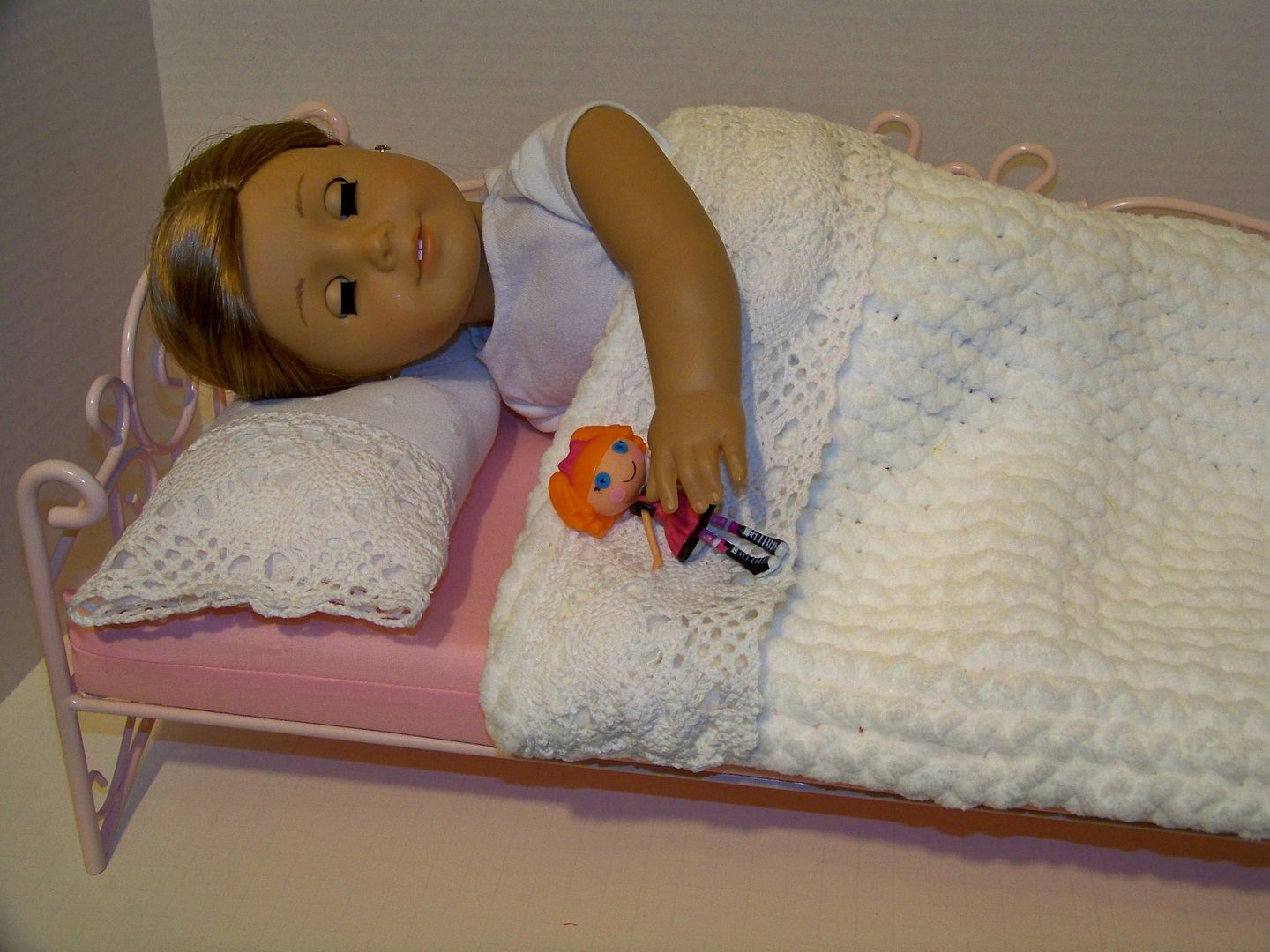 |
| Loom-knitted doll bedding. |
To see many of my previous projects, check My Project Gallery (click here).
To see my previous American Girl projects, check my Doll Clothing and Accessories page (click here).
To see my post on making loom-knit doll bedding (shown to the right), click here.
Thank you for checking my blog post today!
